Just
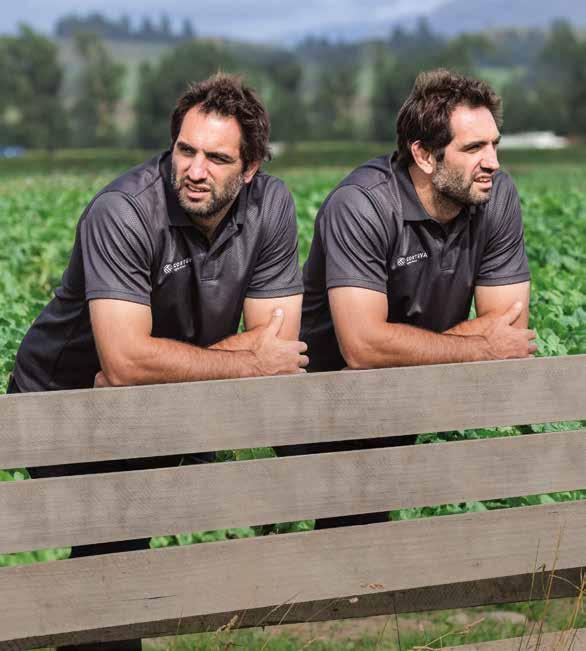



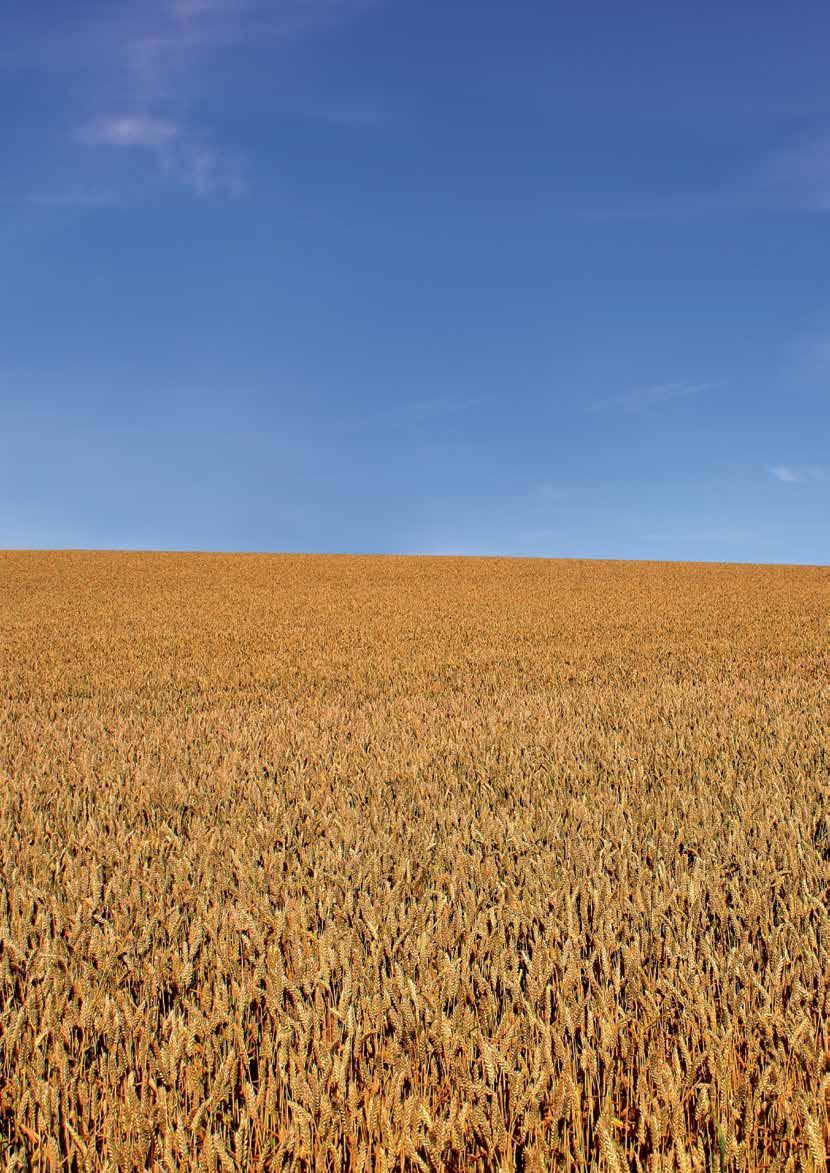
INDUSTRY NEWS
Grain Mark highlights ‘phenomenal’ local quality
CROP PROTECTION
New entrant bucks the trend
PRODUCT UPDATE
Eco-friendly timber barn formula for viability

Just





INDUSTRY NEWS
Grain Mark highlights ‘phenomenal’ local quality
CROP PROTECTION
New entrant bucks the trend
PRODUCT UPDATE
Eco-friendly timber barn formula for viability






Long-lasting disease control in wheat crops.
Proven rust control in ryegrass seed crops, with a short 14 day withholding period.
For more information please call the Syngenta Technical Advice Line on 0800 333 336 FREE NOZZLES
Solo SDHI formulation for tank mix flexibility. Ryegrass endophyte safety confirmed.
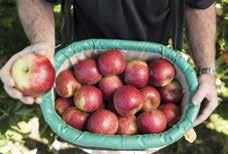
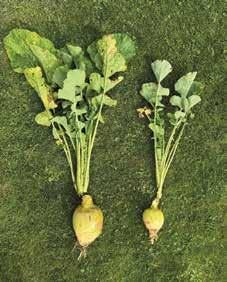
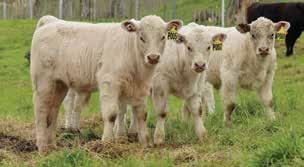
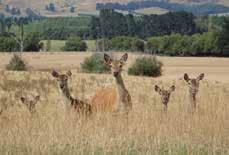
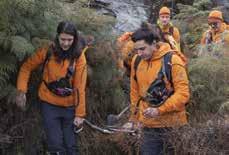










Editor Kathy Davis 0274 347 108 kathy@thelastword.net.nz
Advertising Manager Lisa Phelan 021 782 228 lisa@agrimedia.co.nz
Production & Design Amanda Vroombout 027 7788 274 production@agrimedia.co.nz
Accounts & AdminHilary Armstrong027 443 3477 accounts@agrimedia.co.nz
Printed by Blueprint 2022 Limited03 348 0538 michael@blueprintmedia.co.nz
No part of this
may be reproduced in any form without the prior written permission of the
Opinions expressed in this publication are not necessarily that of the publisher and suggest independent advice be sought before acting on information or suggestions contained herein.
Editorial and photographic contributions are welcomed and should be sent directly to the
Kathy Davis. Editing of submissions is at the sole discretion of the editor and will accept no responsibility for unsolicited material.
Welcome back to Agribusiness and Agrivet for our final issue of 2025.
The local body elections are now yesterday’s news, but one thing that really struck me this time around was the response from the rural community, both in terms of voting and standing as candidates.
I’m always shocked at how few New Zealanders vote in these elections full stop, but against the lowest overall voter turnout in 36 years, rural turnout for 2025 was 43.6 per cent, and in provincial cities it was 38.3 per cent.
By contrast, not even a third of metropolitan voters bothered to cast a ballot. Says it all, really.
Nearly 70 candidates linked to Federated Farmers have been elected, meaning farmer voices will be heard loud and
clear in council chambers over the next three years.
Bring it on. I’m surely not the only ratepayer in New Zealand wondering when practicality will return to the table, not to mention even the vaguest sense of frugality.
Meantime, while the weather has delayed spring in many parts of the country, we’re in the crop protection season.
For the latest industry news as well as expert advice on helping your clients grow high yielding, profitable forage crops and keeping pastures clean and productive, head to our bumper annual focus on all things agchem, starting page 8.
There you will also find the inside story on a new entrant to the local market,

info@sipcam.co.nz www.sipcam.co.nz

determined to fill a niche with innovative, speciality products and a focus on minor crops. It’s an encouraging read in the wake of Bayer ceasing crop protection research in NZ.
Thanks again to everyone who has shared their stories, advice, insights and support with us this past year. We couldn’t do it without you! If you do get a break over the holiday season, have a wonderful time, and if you’re working through, here’s to a good spell of R&R after the rush is over. We’ll be back in January.

Just as balanced nutrition is essential for people, it’s just as important for the crops and pastures that drive New Zealand’s rural economy. Every nutrient plays a part in plant growth, resilience, and yield – but it’s how these nutrients work together as a system that really makes the difference. For farmers and growers, this means looking beyond just single products for ultimate uptake and stress management, so they can get the best results from their land.
As you know, amino acids, for example, are the building blocks of protein and play a key role in both plant and animal health. In plants, they help with nutrient transport, enzyme activity, and stress tolerance – directly impacting crop quality and productivity.
At Sipcam, we’re bringing our new approach to plant nutrition. One that’s proven globally and backed by science and evidence. Refined in the field, its designed for real-world results.
Keep an eye out for our upcoming nutrition product range, launching this season.
Talk to us about how Sipcam can help your farmers and growers grow stronger, healthier crops and pasture.
Manufacturers are already showing interest in the arable industry’s new trademark to make it easier for consumers to buy local grain products.
The ‘New Zealand Grown Grains’ logo was launched last month and growers hope it taps into a strengthening desire by consumers for locally-sourced food as well as reduce reliance on imported product. Products using the Grain Mark can include up to 20 per cent of imported or blended ingredients, to allow for things such as yeast which may not be available domestically.
Grain Mark ambassador celebrity TV chef Nadia Lim told the launch that it will ‘open up the conversation’ and lift consumers’ awareness.
Most people don’t realise when they buy bread from the supermarket it is more likely to be made from imported rather than domestically-grown milling wheat. This is despite NZ arable growers producing some of the world’s best quality grain.
The Grain Mark for products made with NZgrown grains is the initiative of growers via the Foundation for Arable Research. General manager of business operations
Ivan Lawrie says the certification trademark will start appearing on packaging and advertising, with interest already shown by bakers as well as makers of breakfast cereal and plant-based milk.
The trademark not only applies to milling wheat, but also other grains such as oats,
barley and maize, as well as seeds.
Mid Canterbury mixed arable farmer
Brian Leadley says it is disappointing to be competing with imported milling wheat, but also challenging.
“We are proud of the milling wheat we produce and want to see more of it used.”
His 450 hectare farm near Ashburton grows 13 different types of crops in any year, as well as farming livestock.
About a quarter of his cropping area is in cereals, mainly milling wheat, but he also grows clover and ryegrass seed for pasture, as well as specialised seeds including evening primrose and red beet.
Phil Jackson, group general manager of Farmers Mill in Timaru, which has just been purchased by flourmill company Mauri, says it only processes South Island-grown wheat.
“The biggest challenge is freight and getting product from the South Island to the North Island.
“The Grain Mark is significant as it is an opportunity for us to get people to be aware of what we do in NZ.”
Managing director of large-scale catering group Compass Paul Harvey, told the launch a growing desire to source product from within NZ meant it is now including this in its tender documents.
As Compass produces 170,000 meals a day
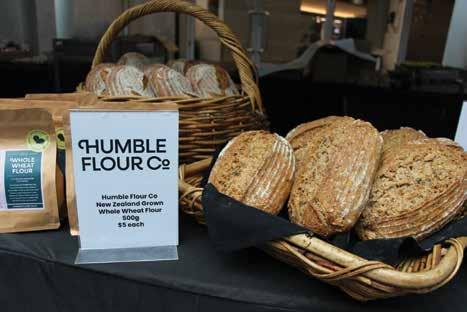
for schools, hospitals, the defence force and businesses, quality and consistency of ingredients is key.
It sources $20 to $25 million of grain-based product a year.
“The quality of grains in the South Island is phenomenal and if we can tell that story, I am in no doubt the volumes and benefits will come.
“Regulatory change isn’t going to happen so we need to take on this ourselves,” Harvey says.
Andrew Fearnside, owner of Wild Wheat, an Auckland bakery producing artisan, specialty breads, says he is proud to be one of the first to sign up and use the NZ-Grown Grains logo.
He sources 12 tonnes of NZ-grown wheat a week for his six stores as well as other businesses, including supplying My Food Bag.
“The provenance of our flour is a good story and we are a shop window for the growers,” he says.

Farmlands has opened its new Hastings store, part of what it says is the co-op’s ongoing strategy to invest in the region and a major milestone in its 63-year history in Hastings.
The new store, located alongside the Horticulture Hub, will deliver a more streamlined experience for customers by combining retail supplies and bulk feed services in one convenient location.
Farmers and growers will have access to a larger range of rural supplies, along with new drivethru bulk feed and pick-up options to save time and help them spend more of their day on-farm.
“For 63 years, Farmlands has stood alongside the farmers and growers of Hawke’s Bay. Each person here tonight has played a role in our past, present, and future,”
chairman Rob Hewett told the opening event.
“This new site isn’t just about looking back; it’s a powerful symbol of our unwavering support for this region and a promise to continue investing for the future.”
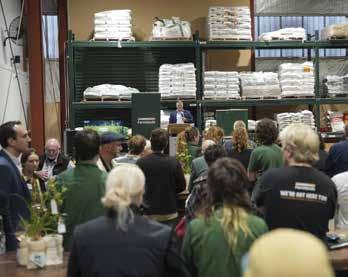
CEO Tanya Houghton says the co-op is proud to keep investing in the region.
“This new site is about delivering a better experience for our customers – with more space, more services, while strengthening our connection to the region and the needs of local farmers and growers.”
The new site also incorporates enhanced digital services, including in-store support for FarmlandsPRO, helping
shareholders connect seamlessly both online and in-store.
With expanded stock, expert advice and a modern retail space, the new Hastings store is designed to meet the evolving needs of NZ’s rural and horticultural sector, and will strengthen Farmlands’ connection to the region for generations to come, it says.
Seed and Grain New Zealand (SGNZ) and the Australian Seed Federation (ASF) have successfully co-hosted the inaugural trans-Tasman Seed Business 2025 conference in Christchurch, bringing together the seed industries of both countries for four days of events.
The conference attracted more than 250 delegates from seed companies, regulators, seed services and exhibitors, making it the first forum of its kind dedicated to strengthening trans-Tasman collaboration. With a strong focus on networking, information exchange, trade, and policy discussions, participants highlighted the shared opportunities for growth and innovation across the sector.
ASF president Tim March says the conference demonstrated the strength of collaboration.
“Seed Business 2025 showed just how much we can achieve by coming together as two industries.
“The energy, the openness, and the willingness to share ideas made it clear that Australia and NZ’s seed sectors have a strong future working
side by side.”
SGNZ president Charlotte Connolley agreed.
“This event was a chance to build deeper connections across the Tasman. It reinforced the value of working collectively – learning from each other and identifying where we can grow together.”
The conference was made possible by over 40 sponsors, supporters, and exhibitors.
Day one started with a networking breakfast hosted by SGNZ’s Young Radicles committee with guest speaker Crusaders coach Rob Penney.
Associate Minister of Agriculture Nicola Grigg opened day two, highlighting the critical role of the seed industry in underpinning primary industries.
She emphasised the government’s focus on
improving regulatory settings to support the primary industry’s contribution to the goal of doubling-export values by 2034, noting that the reform of the Resource Management Act ‘is a big ticket regulatory item’.
At the gala dinner, John McKenzie, former CEO of PGG Wrightson Seeds Oceania, was
recognised as a life member of SGNZ for his decades of contribution to the industry.
The overwhelming response from participants has ensured that the joint Seed Business model will return in the future, continuing to provide a platform for the Australian and NZ seed industries to connect and collaborate.

Drontal™ Tasty Bone provides New Zealand farmers with the same trusted worm control and treatment for Giardia* as the Drontal™ for Dogs Flavoured Allwormer tablets it replaces.
Drontal™ Tasty Bone is a unique, bone-shaped tablet, made from 100% pork liver meal. The real meat flavour makes worming more appealing to dogs, taking the hassle out of deworming for farmers and their hardworking dogs.
Now available from your preferred wholesaler.



*Only Drontal™ for dogs controls the shedding of Giardia cysts. Treatment for Giardia infestation should be done under veterinary supervision. Read product label for full instructions.
Drontal, Elanco and the diagonal bar logo are trademarks of Elanco or its affiliates. Drontal™ Tasty Bone for Dogs is registered under the ACVM Act 1997, Nos. A011225, A011600. Elanco New Zealand, 106 Wiri Station Road, Manukau, Auckland 2104. www.mypetandi.elanco.com/nz | 0800 446 121 © 2025 Elanco. PM-NZ-25-0158
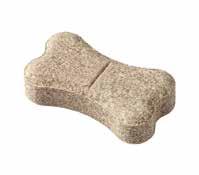
Vital trade paperwork giving our plant and timber exports access to overseas markets is about to get much more expensive, and the only unknown at this stage is if the hit will be short and sharp, or slow and gradual.
MPI is the best part of three million dollars in the red for issuing phytosanitary certificates over the past two financial years alone, and wants to make up that loss in 13 months, starting straight away. That would mean the cost of getting plant products certified for sale overseas – including big ticket export earners like kiwifruit – would more than double from $38.29 to $109.25 per certificate from 1 December. In 2024/25, MPI issued nearly 61,000 phytosanitary certificates for plant products, the vast majority of which are fruit, vegetables, seed, grains and nuts.
The proposed immediate increase in certificate fees would cost kiwifruit exporters $751,000
and apple exporters over $1 million for the 13 months ending 31 December 2026, according to MPI.
After that, plant product certificate fees would drop closer to $60 each.
The ministry released its cost recovery plan 6 October, giving respondents three weeks to feed back on a single point – whether the plan is deployed over 13 months, or three years, as is the normal policy.
At current fee rates and expenditure, the phytosanitary service will run at a loss of $7.276 million by 2027/28, the ministry says.
It has already transferred $2.818 million of deficit accumulated by the system before 30 June 2023 to NZ
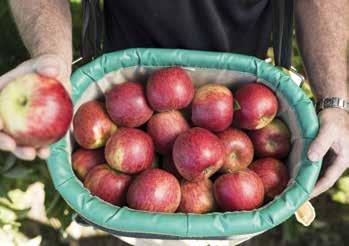
Apple exporters could pay up to $1 million more this coming year.
taxpayers via the Crown under the then Labour Government.
Nonetheless MPI still spent $1.5 million more on phytosanitary certification than it earned for 2023/24, and closed its books for the service on an accumulated loss of $2.731 million for 2024/25.
MPI blames the continual shortfalls on less revenue caused by a temporary drop in certificate volumes in the four years to June 2024, plus rising service costs.
It says costs have risen because of inflation, and enhanced certification processes to meet the needs of trading partners. It also says increased market access activity has contributed to cost increases, as have system investments.
These investments include the 2019 launch of an electronic interface that just three years later was described in MPI tender documents as one of five
‘aging systems’ to be replaced with a completely new cloudbased technology package.
Between the years ending 2021 and 2025, MPI’s expenditure on total plant and forestry export certification rose 36 per cent from $2.424 million to $3.301 million, or approximately seven per cent a year.
It says expenditure will rise a further 15.9 per cent to $3.826 million by 2027/28, most of which is related to MPI personnel.
The service had 13.36 full time equivalent employees in 2021/22, compared with 15.28 in 2024/25.
Personnel and overhead costs for 2025/26 are forecast to be $322,000 higher than 2024/25, a rise of 18 per cent in 12 months.
“The increasing personnel and overhead cost is due to increased effort required by MPI staff to maintain current levels of servicing,” it says.

Dairy Women’s Network members have until the end of January to apply for a new $50,000 scholarship fund launched to develop their leadership skills.
The network has partnered with vet diagnostic equipment supplier IDEXX to create the fund, and successful recipients will be announced in February.
This initiative will award scholarship/s up to a total of $10,000 per year, over five years.
The fund’s total commitment of $50,000 will create sustained impact by enabling women members of DWN to access leadership training, courses, conferences, and mentorship programs, the organisation says.
“DWN is thrilled to partner with IDEXX on this meaningful initiative,” says CEO Jules Benton.
“We know that leadership capability among women is not lacking—it’s the opportunities and resources that often are. This fund helps bridge that gap.”
As well as funding leadership training, the scholarship will strengthen networks and support structures for successful application, positioning them for success in governance and
management roles within the sector.
Christopher Lambeth, commercial leader, IDEXX Australia and New Zealand, says his company is passionate about supporting people who help shape the future of farming.
“Partnering with Dairy Women’s Network to launch this scholarship fund is especially meaningful; it helps open doors for women in the dairy sector to step into leadership roles and make their mark.”

Samuel Whitelock – Plant Science Graduate, Lincoln University.
I’ve had some great teammates over the years and my friends at Corteva Agriscience are up there with the best of them.
Their suite of world class products – including Tordon ® Brushkiller XT, Tordon ® PastureBoss ®, Korvetto ®, Sparta ®, Transform ® and TwinGuard ® – helps farmers achieve truly exceptional results.
Corteva are on a mission to enrich lives for generations to come – and that’s exactly the kind of company I want on my side.

For more information talk to your agricultural merchant or call 0800 803 939 today. Always read the label before use.
this month we look at...
It’s not just armies that march on their stomachs. Slugs do too.
The gastropods (Greek for ‘stomach foot’) can cover significant distances in search of food, travelling up to 13 metres in one night.
Unfortunately for growers and farmers, this is combined with a voracious appetite.
Slugs can consume more than 50 per cent of their own body weight.
Unprotected, damage to plants can happen surprisingly quickly.
Pieter Van Der Westhuizen, UPL NZ regional manager upper North Island, says monitoring is vital.
“Ideally, you should be monitoring the slug population early, using a damp sack and checking under it regularly. Even one slug can indicate that there’s a problem.
“Looking for dead slugs is not the best way to access a bait’s efficacy. Instead
check for crop damage. No damage indicates an effective bait programme.”



Twenty different plant species were evaluated, with two molecules being selected that slugs found irresistible.
Van Der Westhuizen says they don’t hold back when eating the bait.
Once crops are planted, Van Der Westhuizen says Ironmax Pro should already be on the ground. “Slugs are aware of seedlings, even as plants are just breaking the surface.
“By the time slugs are feeding on emerging seedlings, it’s too late. Seedlings damaged by slugs usually won’t recover.
“The goal is to protect the crop. Once feeding damage has stopped, that‘s been achieved. We don’t have to see dead slugs to know we were successful.”
Van Der Westhuizen says slugs, which have an acute sense of smell, are attracted by Ironmax Pro thanks to Colzactive technology, a specially selected oil seed rape extract and one of slugs’ favourites.
“Ironmax Pro is highly attractive. It’ll be the slugs’ final meal. They’ll eat it - even in preference to seedlings – and won’t stop until they’ve consumed a lethal dose, before going underground to die.”
While lethal to slugs, the bait is much safer for beneficial insects, farm dogs, and other domestic pets.
“Stock break-outs and gates accidentally left open are part of farming life, no matter how careful you are,”
Van Der Westhuizen says.
“Similarly, the family labrador, or huntaway, needs to be safe when it’s stretching its legs or working on the farm.
“With Ironmax Pro, there’s no problem –it’s also safer for beneficial insects. And while the slugs will sniff Ironmax Pro out, it’s definitely more pleasant, in terms of odour for those working with it – especially in confined spaces.”
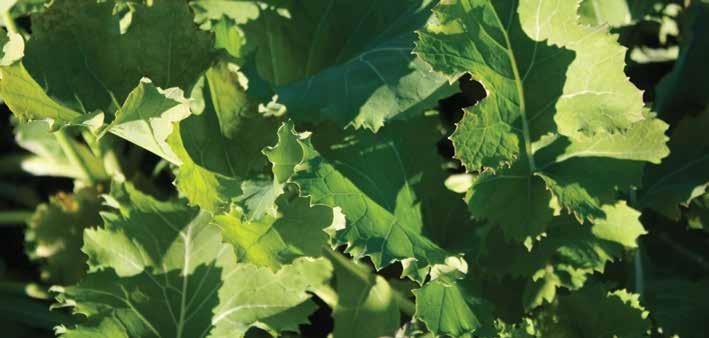
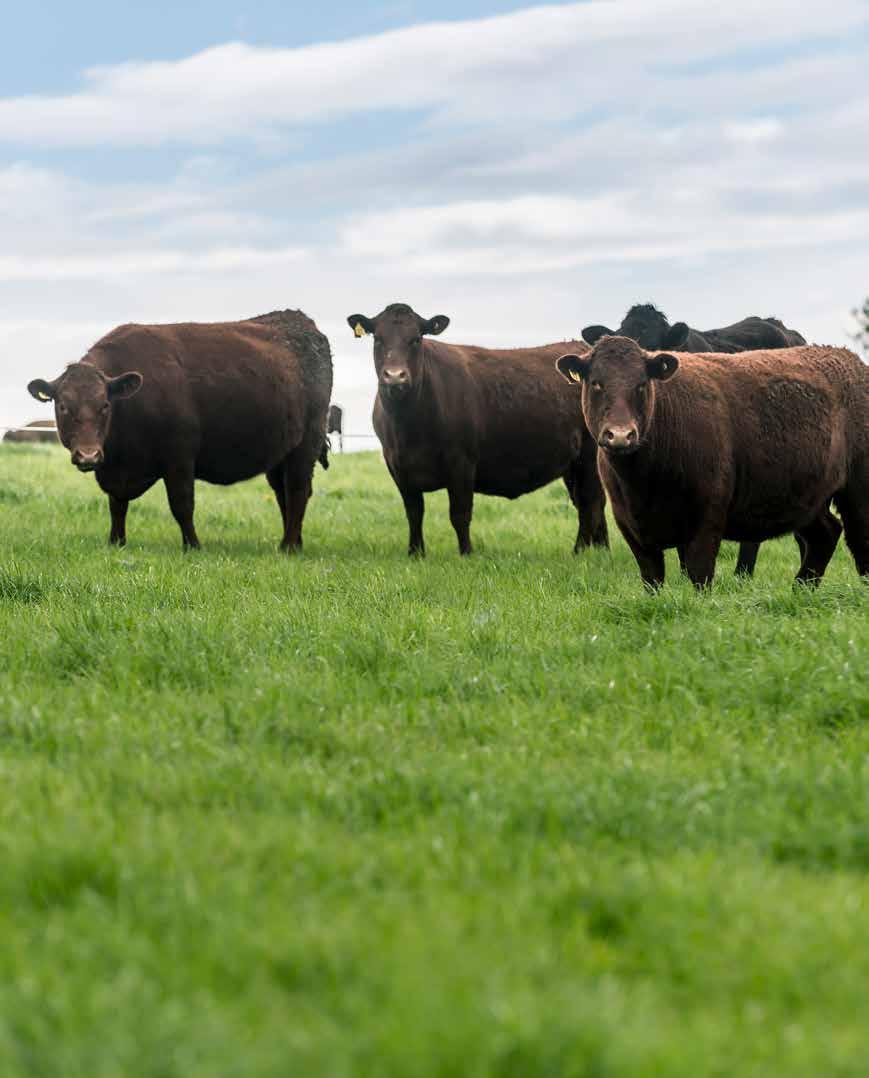
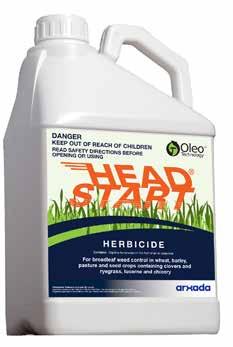

Why would a new crop protection business, with a special interest in innovative products, bother entering the New Zealand market when bigger players struggling with some of the longest regulatory timeframes in the world are pulling back?

The team in question agrees it might sound contrarian, but says that’s a strength, not a weakness, and there’s no shortage of business potential here if you step back and look at things a bit differently.
For AgNova NZ, that means a 10 year perspective (not five years); focusing on development, not discovery; leveraging a unique trial protocol that satisfies regulators both sides of the Tasman instead of just one or the other, and making the most of extensive offshore resources.
Add to that a small, highly experienced crew of local industry veterans plus a well-connected parent company whose investment metrics emphasise rather than play down so-called minor crops, and you can begin to see why the effort is being made.
Country manager David Chamberlin says the NZ business model closely follows that of AgNova Technologies in Australia.
It has done so well with niche and speciality products in that market over the past 22 years it has been appointed development partner for more than a dozen international entities based in the United States, Europe and Japan.
Being purchased by American Vanguard Corporation in 2020 has only served to further broaden the global resources available, including access to more products particularly in biologicals, fermentation capacity, chitin-based and plant stimulants.
“Our philosophy is to do the same here – bring in and develop products from international research companies which are not directly represented in NZ, and invest the time and money to develop them for local producers,” he says.
Chamberlin heads a team of three whose combined skills and experience more than
make up for their small number.
George Follas came on board in 2023 as development manager, and works with the Australians to optimise product development between the two countries, and best utilize trial work done both sides of the Tasman.
(It was Follas who devised the combined trans-Tasman regulatory trial protocol, something Chamberlin says plays a pivotal role in streamlining AgNova NZ’s path to market with new registrations.)
Mike Goodwin joined as area sales manager for the South Island last August, bringing with him arable expertise particularly in seed and forage crops, improved pastures, molluscicides and adjuvants, as well as a strong focus on wine grapes, cherries, potatoes and onions.
Long-time Hawke’s Bay resident David Lingan joined earlier this year, bringing horticultural expertise across all crops, and valuable knowledge in adjuvants, molluscicides, sun protection and bird repellency in particular.
Chamberlin himself, who is also responsible for sales in the upper North Island, has a long history in the primary sector, including 21 years in crop protection with Bayer in a range of roles spanning NZ, Australia, Vietnam, Germany, Singapore and Indonesia.
He was working outside the industry when the call came about leading AgNova NZ, and says the opportunity was too good to let pass.
“All four of us are excited about the challenge of setting up a new business and bringing innovative new products to the NZ market.
“We’ve all been in crop protection for most of our careers; we understand the market, and we can see real potential for a development-based business strategy,
which has become very difficult here for some companies.”
He acknowledges the regulatory timeframes are still challenging, notwithstanding the ‘amazing job’ done recently by industry representatives to accelerate the process, but says AgNova is well structured and resourced to handle these.
In the past season alone, it completed 17 product trials in wine grapes, kiwifruit, potatoes, onions and cherries. More than 30 trials are committed for the coming season. Current work also includes trials and demonstrations in knock-down weed control, fallow, maize, cereals, forage brassicas and seed crops.
The existing portfolio features fruit and vegetable products like Baron WG and Unyunox herbicide; Ohayo fungicide; Designer Plus sticker and deposition agent; Mesh anti-shatter for seed pod crops and Lucid tank cleaner and decontaminator.
Pipeline products include new developments in GreenSolutionsTM and adjuvants.
AgNova’s founders in Australia prioritized minor crops from the get-go and Chamberlin says the NZ business is equally committed to producers who don’t have the scale necessary to influence investment decisions made by big global suppliers.
“We truly care about all growers and farmers. For us it’s not just the big four crops – we focus on and target the whole horticultural market, as well as seizing opportunities in arable and specialty markets where we can make a difference.”

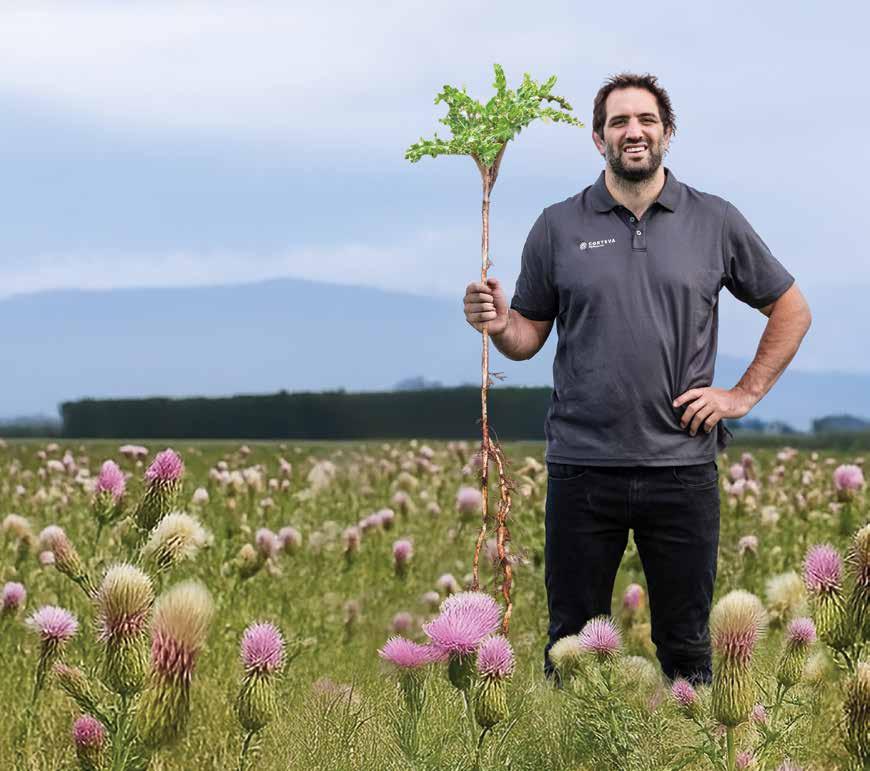
Samuel Whitelock Plant Science Graduate, Lincoln
University.
As farmers know, Californian Thistle is incredibly difficult to eradicate. That’s due to its unusually deep root system, which can burrow as deep as 2.4 metres – that’s taller than Samuel Whitelock.
Not only that, left unchecked, each stem can produce up to the length of a footy field in root every year; up to 4,000 kilometres per hectare! And the fact that they are perennials, unlike their annual thistle cousins, means they just keep coming back (as you know too well!).
But you can tackle the problem once and for all, with Tordon PastureBoss.
We recommend following a three-spray programme, with Tordon Pastureboss as the anchor product, followed by a second application of phenoxy (MCPA) and then spot sprays of Tordon PastureBoss, for lasting results.
And of course Tordon PastureBoss can be used on a wide range of other hard-to-kill pasture weeds. See our website for details.


A unique three-way project between supplier, retailer and farmer is nearing an important milestone as it sets out to prove Californian thistles can be permanently beaten. Before the programme began.
While not yet complete, it has already delivered encouraging initial results for those involved, some of whom have been battling Calis for years with limited success.
Corteva AgriScience and PGG Wrightson launched the initiative 12 months ago, recruiting farmers from across the country to follow an expert, staged elimination programme for one of New Zealand’s most expensive, persistent weeds.
The aim? To restore farmer confidence in the fight against Calis, using hard evidence from eight different case study farms implementing best practice control under guidance of local reps.
Marketing manager Nicole Morris leads Corteva’s involvement.
She says the last of three herbicide applications will go on soon, after which the focus turns to compiling all the results into a package that documents the whole process from start to finish, so other farmers can pick it up for their own use.
“Most of the sites have had their first two applications – Tordon PastureBoss in summer 2024/25, followed in autumn 25 by Grassmaster MCPA.
“Visually the difference is already striking, but being mindful of Californian thistle’s biology we have to get that third spot spray of Tordon PastureBoss on to any remaining plants this summer to ensure a good outcome.”
That’s because success entails not only an absence of thistles, but restoration of productive grass and clover for grazing.
“We want to prove the financial value of this programme to farmers, as well as the concept,” Morris explains.
So key metrics have been noted at each site for each spray, including the number of thistle stems per square metre, a visual assessment of clover content, and an overall estimation of the thistle infestation per ha.
“Ultimately, we’ll be able to relate that information back to regional pasture productivity, using data in the existing literature.”
Meantime, Corteva and PGG Wrightson hope to be able to run a roadshow with open days at case study farms in early
2026 to start sharing initial results of the programme with a wider audience.
Five of the farms are in the South Island; in North and Mid Canterbury, North Otago, and Southland.
The remaining three are in the North Island – Wairarapa, Hawke’s Bay and Waikato.
Sheep and beef farmer Simon Campbell’s 520 ha at Mt Bruce is the Wairarapa case study property, and says his family has fought Californian thistles for generations, with some pastures so thickly infested ‘lambs won’t even go in there’.
Campbell recalls his father spent thousands of dollars trying to control the weed, even using a weed wiper attached to the front of his tractor.
However, despite these efforts, the thistles kept coming back. The farm previously wintered cattle, which would clean up thistle patches after flowering, but this approach only addressed the visual nuisance rather than eradicating the problem.
He got involved with the project to improve pasture quality and overall productivity; has treated an initial 30 ha as a result, and is keen to see the final results.
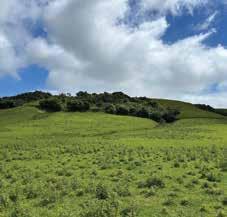
If the three-spray program proves successful, he plans to extend the treatment across the farm in stages.
Nicole Morris says the relationship between local PGG Wrightson technical field representatives and the case study farmers has been pivotal in getting the project up and running.
Joining forces with a retail partner for best practice demonstration like this is a first for Corteva, and a win:win for all involved, she says.
“We know the issue is getting worse; California thistles are spreading and the feedback we’ve been getting is that farmers are becoming disillusioned and losing confidence in their ability to stay on top of them.
“We also realise one of the best ways to promote what can be achieved with a programmed approach control is through using demo sites, and sharing farm case studies.
“But we’re a small team, and we alone don’t have the resources to do this type of extension work at scale, so it made perfect sense to partner with PGG Wrightson on a multi-year national initiative we believe will make a real difference to farmers.”
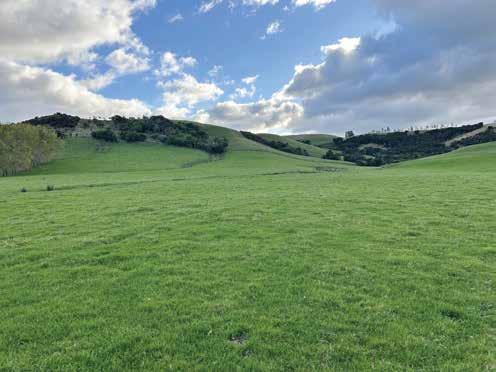
How many times have your farmers told you grass is not a worry in brassica crops because it’s free feed and the cows will eat it?
This season, thanks to results of a new trial, you can hopefully persuade them to see things a little differently.
They’ll be better off as a result, and so too will their animals.
Nufarm technical specialist Sonja Vreugdenhil has some compelling data that clarifies in no uncertain terms the true cost of that perceived free feed.
She ran a dryland brassica trial in Canterbury last season that included comparing the dry matter yield at maturity between swedes that were sprayed post emergence for early grass weed control, and those that weren’t.
Even she was surprised at the disparity between the two.
“It really showed grass is the largest robber of yield in a forage brassica crop. Prevailing weeds in the trial area were couch/twitch and perennial ryegrass, and they would not have covered more than 15% of ground area at the time of herbicide application.
“Yet the difference in crop yield between treated and untreated swedes was 50 per cent, and grass weeds themselves made up only a small percentage of the untreated yield. Treated bulbs were the size of a person’s head, and untreated the size of your fist.”
The trial was sown in a high rainfall area near the foothills in early November 2024, and yield was measured in April.
Weed control was applied to the treated swedes when the crop was at the six true leaf stage, and comprised 3 litres per ha
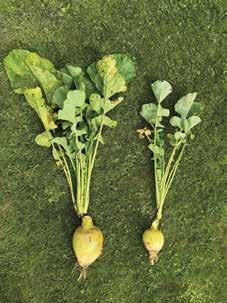
SeQuence, with Bonza Gold at 500 ml per 100 litres of water. Prestige was included for broadleaf control at the same time, tank mixed at 350 ml per ha.
As a way of demonstrating exactly what happens when grass is not controlled in forage brassicas, the trial was very successful.
“Sometimes it’s hard for farmers to visualise how much yield they can lose from what doesn’t seem like a lot of grass infestation in a young crop, especially when they often look at that grass and think of it as free feed.
“So this is a great visual representation of the value of grass weed control. I worked out you would need 500 kg dry matter per ha of extra yield to cover the cost of that herbicide application, which is not a lot in the context of a crop that yields 12-15 tonnes dry matter per ha.”
This work was done on winter brassicas, but the same principle holds true for summer brassicas too, she says.
Every day farmers hold off applying a grass weed herbicide in affected crops can impact their yield.
“If they’re going to put a crop in, they need to look after it, or they will be disappointed when it comes to grazing.”
There’s another equally important reason to control grass weeds: they compete with the new pasture which usually follows forage crops.
“Once new pastures are sown, your farmers do not have an opportunity to
control undesirable grass species.”
SeQuence is a selective herbicide registered for many spring-sown forage crops, including fodder and sugar beet, forage brassicas, chicory, plantain, lucerne, clovers and other legumes.
It contains the active ingredient clethodim (Group 1) and is registered on 22 grass weeds, including ryegrasses, annual summer grasses, wild oats, cultivated couch and annual poa.
Best results come from applying SeQuence when target grasses are actively growing. This only happens when soil moisture and temperature are at the right level to support growth, so it pays to be aware of how conditions are shaping up at the start of the season.
SeQuence must always be applied with Bonza Gold and may be tank mixed with Archer 750 (Group 4) or Prestige (Group 4) if broadleaf weed control is also required in forage brassicas. Attack may be added to SeQuence when pest control is needed.

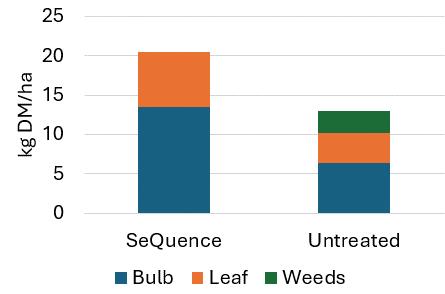
Trusted drum after drum, season after season. Magister® CS Herbicide is built for consistency—because when time’s tight and conditions are unpredictable, you need a product that performs without question.
That’s why more Kiwi farmers trust Magister® CS to deliver when it matters most.


Words: Syngenta Crop Protection NZ
Early in 2025, Vegetables NZ and Syngenta Crop Protection NZ initiated a trial to evaluate performance of Durivo insecticide applied by multiple methods, compared to an untreated control.
The trial was conducted in Pukekohe at Te Ahikawariki – Vegetable Industry Centre of Excellence (VICE).
Eurofins Kalyx was contracted to assess each of the treatments for plant vigour and key brassica pests: diamondback moth, white butterfly, soybean looper, aphids, greenhouse whitefly and onion thrips.
Cabbage (cv. Lambada) was selected due to commercial relevance and extended crop cycle, allowing for robust pest assessments. Transplants were sourced from three different North Island nurseries to compare different commercial applications of Durivo. A hand treated application of Durivo was also made at the label rate for comparison.
Key findings included:
• All Durivo treatments provided effective diamond back moth control until 26 days after application (DAA). Efficacy had declined by 33 DAA.
• All Durivo treatments provided control of aphid nymphs at 26 DAA. The sharp drop in aphid incidence in the untreated control at 33 DAA was likely due to a significant rain event (26 mm) three days prior.
• All Durivo treatments exhibited higher vigour scores at both assessment timings, compared to the untreated control.
All Durivo treatments were comparable for diamond back moth larvae and aphid nymph incidence along with plant vigour.
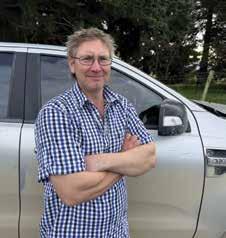
This gives growers confidence in their use of Durivo as a seedling tray drench.
The control of diamond back moth from Durivo for up to four weeks gives seedlings time to establish before other control options are required.
And during high diamond back moth pressure periods, such as summer, the application of Durivo offers growers peace of mind that pests will be controlled during that initial four-week period after planting.
Best use recommendations:
• Apply to leafy vegetables and leafy brassicas at 15 ml/1000 seedlings, and vegetable brassicas require a rate of 25 ml/1000 seedlings.
• Use correctly calibrated equipment to apply as a seedling tray drench and ensure Durivo is washed into the root ball.
• If seedlings require watering following the Durivo application, take care to avoid leaching the product from cells which reduce the duration of control.
• For resistance management against DBM, do not follow a Durivo application with another Group 28 product on that crop.
Durivo (Group 4A, Group 28) is a broad spectrum, systemic insecticide for the control of key insect pests in leafy vegetables, brassica leafy vegetables and vegetable brassicas.
Applied as a seedling tray drench prior to

Untreated seedling.

transplanting, Durivo is readily taken up by the roots of the transplants and rapidly translocated throughout the plant, to give lasting protection and an ‘energy boost’ right from the start.
The Vegetable Industry Centre of Excellence research and demonstration farm has been set up on the Balle Bros property in Pukekohe.
This site is also the home of the Plant and Food Research offices and facilities and the Lighter Touch demonstration site.
For New Zealand’s fodder beet and forage brassica growers, timing is everything— and so is confidence in your crop protection.
That’s why Magister CS herbicide continues to be the trusted choice across the country, delivering consistent performance in the paddock season after season. With its advanced capsule suspension
(CS) formulation, Magister CS offers smooth mixing, even coverage, and reliable control of key broadleaf weeds like wireweed, willow weed, cornbind, cleavers and shepherd’s purse.
If you think you’re seeing a lot more yellow around lately, your eyes are not deceiving you. Michael Bennet.
Tight budgets in recent years have been hard on farmers but kind to gorse, and other brushweeds too.
Fortunately the tide is set to turn, Nufarm business development manager Michael Bennet says.
“A lot of brushweed spraying has been deferred over the past four years, because market conditions were tough and farmers just couldn’t afford to do as much as they normally would.
“They have been spending money to contain bad patches to prevent them spreading further, but there’s a lot of gorse around at present.”
Hardly surprising when a single plant can produce up to 36,000 seeds per square

metre, every year.
Bennet predicts a big season ahead for brushweed control across the board as farmers make up lost ground.
“They have more resources available to do that job, and a lot more optimism.”
It’s a welcome change, and an important one too, because rampant brushweeds and efficient productivity don’t go together, Bennet points out.
“If your customers want to take advantage of better returns, they need all the good grazing they can get.
“Whether it’s big thick infestations on hill country, or scattered plants in dairy pasture, the principle is the same.”
Now’s the perfect time to start helping customers reclaim their valuable land – all that’s needed is a solid plan, and the right herbicide products.
Bennet says key factors to consider before starting any control programme include the brushweed species present; their density and distribution; and how long farmers want to wait before re-sowing pasture seed after spraying.
A common scenario is scattered
Developed using FMC’s global formulation expertise, the CS technology ensures the active ingredient is delivered precisely and consistently every time.
It’s a formulation that’s stood the test of time—tried, tested, and trusted by Kiwi farmers to get the job done season after season. In a market where new products come and go, Magister CS has remained a staple because it simply works, the company says.
Henry Ross, general manager of Molloy Agriculture, knows the value of reliability when the pressure is on.
“We always use and recommend Magister
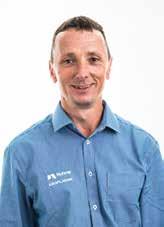
infestations on grazeable land where farmers want to protect the existing grass while still getting rid of gorse, broom or other brushweeds.
In this case, Conquest (Group 4) applied aerially or by handgun can be a good option, he says, because it is effective, fast acting and grass friendly, so it won’t leave brown patches in pasture.
That’s not all it does, however.
“Conquest can also be used for spot spraying broadleaf weeds like docks, thistle and ragwort, including large, multi-crown and difficult to kill species,” Bennet adds.
“In effect it gives customers the ability to tackle two pasture maintenance jobs with one product. It will damage clover, however, so farmers need to take care with applications.”
Conquest contains the active ingredients picloram and triclopyr; is very cost effective and takes out awkward weeds that other herbicides struggle to control, including alligator weed, horehound, inkweed, cape weed, goats rue, fennel, hemlock and sorrel.
“Sprayed weeds rapidly show signs of herbicide application,
CS,” he says, “as we can’t afford any downtime due to potential formulation issues, so we stick with what we know and trust to help us get the job done time and time again.”
That trust is echoed by mixed arable farmer and Mid Canterbury Federated Farmers vice chair, Darryl Oldham, who relies on Magister CS to stay ahead of weed pressure.
“It’s a formulation we trust to work where it matters most,” he explains, “helping us to get the jump on weeds, especially speedwell in our brassicas.”
Agronomists also back its performance.
Nick Williams, director and agronomist at
and full brownout can occur within weeks, so you can see results fast.”
Conquest also has short term residual soil activity which will suppress weeds that try to germinate around the area that has been treated.
For controlling larger, denser infestations of brushweeds, Associate 600WDG (Group 2) is a well-known and affordable option.
However, Bennet says, it will damage existing clovers and ryegrass, and soil residues can persist for up to 12 months, depending on application rate, soil type and climate.
If farmers are targeting gorse in particular, Pulse Penetrant should always be added to Conquest or Associate 600 WDG.
“Gorse has a very thick cuticle inhibiting the uptake of herbicides, so Pulse Penetrant allows uptake through the stomata ensuring sufficient herbicide gets into the gorse plants.”
And he has one last piece of advice: “Coverage is key, so don’t skimp on water rates.”
Best results are achieved when target brushweeds are not flowering at the time of spraying.
Cates, highlights the product’s consistency: “We use and recommend Magister CS because of its excellent formulation and reliable performance in the field. It helps us deliver reliable results for our growers season after season.”
From the Wairarapa through Canterbury, Otago and down to Southland, Magister CS continues to earn its place in New Zealand’s cropping systems, FMC says.
When conditions are unpredictable and timing is tight, it’s the herbicide growers turn to with confidence—because when it matters most, Magister CS delivers.
Words: Tim Redfern, PGG Wrightson Seeds
Applying additives such as insecticides, fungicides, nutrients and biological agents on seed all play a role in protecting seedlings against external stresses, maximising stand establishment and improving the health of young plants.
Globally the seed treatment market is experiencing strong growth and is projected to grow from US$17B in 2025 to US$39B by 2032, driven by factors including increased demand for food production, the rise in environmentally sustainable farming practices and advancements in chemical and biological seed treatment technologies. The crop protection market is rapidly changing, with synthetic chemical options in particular being rationalised.
Consumers are demanding food production that is sustainably produced, which means controlling insect pests, for example, is becoming a more complex task than in the past.
Integrated Pest Management (IPM) will be a key approach for farmers to address pest challenges.
Practices such as crop rotation, mechanical control, companion planting, biological control and targeted chemical control will all play important roles in disrupting insect lifecycles in the future.
The use of seed treatment has a good fit in the IPM approach.
Delivering synthetic chemical control via seed treatment not only targets specific insect pests that compromise seedling establishment, it also reduces the volume of active ingredient being applied to the soil profile by up to 99 per cent in comparison to a whole field chemical application.
In addition, future seed treatments will increasingly feature biological agents to help fight against insects and fungal pathogens.
PGG Wrightson Seeds has been the leading provider of seed treatment products to the New Zealand forage seed market for over 50 years.
The company has a range of treatments and seed coatings, providing early crop protection solutions across forage brassica, forage grass, legume and herb seed.
The seed treatments are sold under three well established brands; Ultrastrike, Superstrike and Prillcote - and are applied to an extensive range of cultivars from the PGG Wrightson Seeds and Agricom brands.
On the operational side of the business the company has invested heavily in specialist seed treating plants at key locations to support the volume of seed currently being treated and the anticipated future growth. Product development is an important focus for PGG Wrightson Seeds in the seed treatment space.
Over the years the seed treatment
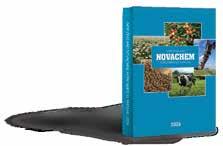

formulations have been updated and improved as new technologies enter the market.
Today the individual formulations include a range of additives, including market-leading insecticide and fungicide chemistry, micronutrients and in the case of legume seed, nitrogen-fixing bacteria.
All treatments include specialist seed polymers which have dual benefits of holding active ingredient on seed and minimising abrasion which protects applicators, drilling operators and the environment.
The company has partnerships with leading international crop protection companies who are research focused and have a pipeline of new technologies in the chemical and biological markets. In recent years PGG Wrightson Seeds worked alongside NZbased company Seed Innovations to develop a heavy-build seed coating product that has allowed contractors to precision plant swede seed, which has been a game changer for farmers in terms of significantly increased crop yields.
With the crop protection market continuing to evolve and rationalise, seed treatment will continue its upward trajectory in the marketplace, providing solutions for farmers, mitigating risk and helping ensure the investment in high value forage seed is protected.





Words: Neil Waddingham, Bayer New Zealand
The livestock sector is booming and so is demand for high quality forage, be it forage brassicas or fodder beet.
Unfortunately, several pests are keen to make a meal of fodder crops, therefore the recent registration of Sivanto prime earlier this year is welcome news for New Zealand farmers.
Sivanto prime stands out as a truly modern insecticide through a combination of efficacy, formulation technology and favourable beneficial profile.
Sivanto prime is based on the active ingredient flupyradifurone and is unique in being classified as a Group 4D insecticide. It delivers extremely effective control of nysius, springtails and green peach aphid during crop establishment.
At the same time, it has minimal impact on beneficials, including honeybees, if used according to label recommendations.
Insects are controlled in several ways with Sivanto prime.
The main ways are when the pest comes into direct or indirect contract with the product.
Direct contact occurs when the insect is directly exposed to Sivanto prime, whereas indirect occurs when pests walk across treated soil or leaf surfaces.
Because Sivanto prime is translaminar, meaning it can move from the top leaf surface through to the lower leaf surface,
pests will be controlled whichever leaf surface they walk on.
Pests do not have to feed on the plant to be controlled but if they do ingestion is another way Sivanto prime works.
Nysius and springtails feed on the plant causing physical damage, whereas with green peach aphids the main threat is virus transmission.
Awareness is growing that viruses are having a significant impact on plant health, fodder quality and yield.
While beet yellows virus is the easiest to spot, turning the leaves of fodder beet bright yellow, there are several other, less visual viruses, that reduce yield in both forage brassicas and fodder beet.
Virus transmission occurs rapidly.
Once a virus-infected aphid feeds on a plant, it takes a very short time for the virus transmission to occur.
However, because Sivanto prime works very quickly to control pests and stop them feeding, it is very effective at shutting down virus transmission.
Sivanto prime is very straightforward and convenient to use.
Formulated as a soluble concentrate, it disperses rapidly in water to give an almost colourless, low-odour spray solution and

aphids and protect against virus yellows.
because it rapidly penetrates the plant the use of an adjuvant isn’t required.
However, it can be mixed with a wide range of other products and some of these products might require an adjuvant; if this is the case the adjuvant should still be applied. Beneficials are your partner for pest control, and it is never too early to protect them.
They play a helpful role by prolonging pest control and diminishing the risk that pest populations flare up when insecticide activity begins to diminish.
You can confidently integrate Sivanto prime into IPM programmes as it has a minimal impact on beneficials, including honeybees, if used according to label recommendations. There is a constant threat of insecticide resistance developing and an important way to reduce this is by integrating different modes of action into your spray programme. As the only Group 4D insecticide registered in NZ, Sivanto prime diversifies your insecticide choice.
Sivanto prime is available now in a 3-litre pack.
At a low dose rate of 150 mL – 375 mL/ha, this pack controls pests across 8 – 20 ha. From December a 10L pack will be available.

Providers of both AgChem and GreenSolutions™ for the New Zealand market with an active development program in New Zealand


Words: Arxada
Headstart, containing 50g/l flumetsulam with inbuilt adjuvant technology, has established itself as a key tool for early weed control in pasture and chicory.
Establishing a new crop is an expensive exercise.
For the best results and persistence for these crops, early weed control is critical to improve crop performance – meaning more feed when you need it.
Unlike other herbicides, the timing of a Headstart application is not governed by crop stage.
Proven by field trials, demonstrating crop safety with effective weed control, recent additional label claims now allow it to be applied as a post-plant pre-emergent option over pasture, and it can be applied any time after emergence over chicory.
This increased flexibility for applications, from sowing to emergence, provides confidence around crop safety, achieving efficient weed control at the most appropriate timings.
Formulated, developed and manufactured in New Zealand with Arxada’s Oleo Technology built into the formulation, allows for improved results in the field, by incorporating the active ingredients with all the necessary surfactants and oils making Headstart unique in the market.
The liquid formulation is easier to measure and mix, compared to granular products which then also require oil to be added to the tank mix.
The improved results achieved in the field with Headstart have allowed nine* extra weeds to be added to the label, over and above what the granule versions will control.
The increased efficacy is due to the optimal ratio of active ingredient with adjuvant in every spray droplet delivered to the target.
Using sufficient water rates is key to success, as coverage is a key factor when using a flumetsulam-based product.
Headstart is compatible with several other pastoral herbicides for controlling broadleaf weeds.
In fact, the adjuvants and oils present in the Headstart formulation can enhance the herbicidal activity of tank mix partners.
The mixing of Headstart with MCPA and MCPB based herbicides is not uncommon and will improve thistle control as well as a
range of other broadleaf weeds.
Headstart is also compatible with grass weed herbicides like clethodim, for controlling unwanted grass species in chicory crops.
Please consult your Arxada territory manager when attempting these mixes to ensure the correct mixing order and always adhere to the label instructions.
How to get the best results from Headstart?
Apply when the weeds are small and actively growing.
Moist soil conditions also enable longevity on the soil, if left undisturbed. If weeds are under significant stresses due to moisture availability or temperature extremes, the efficacy may be reduced. Caution should be observed when applying Headstart in hot, dry conditions as the inbuilt surfactants (as is the case for any flumetsulam + oil combination) can cause adverse crop burning, especially to legumes, but you can be confident that
they will grow out of it.
It is also worth noting that Headstart has no effect to ryegrass or clover when applied anytime from sowing, other than the precautions above.
Headstart also has claims for use over lucerne and cereals (barley and wheat), making Headstart a staple option in your spray shed.
*Extra weeds are nodding thistle, broadleaved dock, inkweed, storksbill, twincress, dandelion, hawkbit, scrambling speedwell and field madder broadleaf weeds. Consult your field representative for further advice before considering a specific tank mix partner for Headstart.


Building a composting barn has cut one Canterbury dairy farm’s environmental footprint by nearly half while protecting cows and pastures alike on land with imperfect drainage.
Owner Brent Thomas calls it a formula for viability as milk payouts climb, while general manager Matt Iremonger sees it as a practical fix for tough land.
Willesden Farms in Banks Peninsula’s Kaituna Valley is a 300 ha conversion, milking 700 cows this season.
Before the barn, wet winters turned paddocks into mud traps, with cows slipping and pastures taking a beating.
Now, cows are under cover during both rain and hot spells, keeping pastures safe from damage during the wet, and cows shaded from heat stress.
Iremonger didn’t rush into this.
He researched composting barns across New Zealand, Australia, and the United States, visiting sites in Waikato, Taranaki, Southland, the West Coast, and Canterbury.
“We looked at how these systems were able to augment our pastoral system,” he says.
The goal was to squeeze more value from wet winter land without ditching pasture, and supplier Numat Agri was chosen for the project.
The barn serves two purposes: wintering 550 – 650 non-milking cows in June and July, and sheltering up to 800 during bad weather.
“It’s designed for the full eight hundred during adverse weather at any time of the year,” Iremonger notes.
That covers spring rains, autumn mud, and summer heat for shade.
Thirty one metres wide by 185 metres long, the barn has 3500 cubic metres of woodchip bedding, with 740 metres of feedface.
The frame uses NuSpan laminated timber—essentially glulam—sourced from sustainable NZ plantations.
This eco-friendly alternative to steelframed barns is up to 20 per cent more cost-effective than traditional builds.
It also handles moisture in effluent-heavy settings without corroding.
“We were really attracted to it because it was cost efficient, and highly durable,” Iremonger says.
Plus it delivers a warmer, softer space that fits the farm’s vibe.
Built for 50+ years, the barn is a long-term play.
“We’ve modelled it as a 50 year piece of infrastructure but there’s no reason that it wouldn’t last significantly longer,” he says. Return on investment lands in five years, with profits rolling in after from higher productivity and lower costs generating savings on off-farm wintering - no more trucking cows off-site.
In severe weather, both cows and staff are more comfortable, and less stressed.
The barn cuts methane and nitrate outputs, key culprits in dairy emissions.
By keeping cows indoors during wet spells, nitrogen leaching drops from 15-20 kg per ha annually to near zero, per industry benchmarks.
Monitoring during consenting shows net gains, putting Willesden ahead of the curve. Opportunities abound for growth.
High milk prices fuel conversions, with Canterbury seeing consents surge fourfold since last year.
Exports to markets like China drive demand, while NZ’s low-cost production edge keeps farms competitive globally.
Milk output is set to rise, with herd

numbers increasing through reduced culling and new setups.
The upsides pull farmers in.
Dairy offers higher returns than dryland grazing on similar land, with asset values climbing in areas like Southland.
Numat Agri says tech like composting barns tips the balance: they cut nitrate leaching by up to 50 per cent, slash methane via better feed efficiency, and enhance sustainability for long-term business resilience.
Willesden’s case fits the pattern.
On Banks Peninsula’s wet slopes, the conversion swaps cropping for year-round grass, avoiding exposed soil and boosting fertility.
The barn’s 46 per cent footprint cut - via captured effluent and indoor sheltermirrors sector-wide moves to meet 2030 emissions targets without slashing output. Iremonger’s research echoes broader farmer caution: conversions work when paired with systems that protect assets long-term, turning compliance pressures into straightforward advantages.

Words: Zoetis

Effective parasite control is a key factor in keeping horses healthy, energetic, and performing at their best.
Today’s approach emphasises strategic, evidence-based programmes that reduce parasite burdens, prevent resistance, and keep dosing simple and safe.
Equest Plus Tape, Promectin Plus LV, Promectin Plus Paste, and Lice N Simple are all useful options within a comprehensive worm and lice management programme.
In adult horses, the main internal parasites of concern are small strongyles (cyathostomins), with tapeworms and roundworms more relevant in younger horses.
External parasites like biting lice cause intense itch, hair loss, and poor coat— especially in winter in older horses or in herd situations.
A targeted deworming schedule anchored to faecal egg counts (FEC) is ideal.
Horses should be tested at least once per year to help identify whether they are high or low shedders.
More frequent treatments can then be targeted at the high shedders which will reduce pasture contamination for both them and the low shedders.
Horses should generally only be treated when their FECs are over 200 eggs per gram, however, this will depend on their age, health status and how hard they are working, with higher FECs acceptable in low risk animals.
Ideally a FEC should be repeated two weeks after treatment to check drench efficacy. Strategic annual treatments for tapeworm are commonly timed in late autumn/winter. Effective deworming is only one component of parasite management; reducing pasture contamination remains key.
To that end, picking up dung and cross grazing with sheep or cattle is also vital if our products are to remain effective.
Equest Plus Tape paste is a powerhouse option for broad coverage, including tapeworms.
Its standout feature is an extended egg reappearance period of approximately 16 weeks, meaning longer protection between doses especially in contaminated environments.
With a potent dose of moxidectin, it is one of the few wormers able to kill encysted
cyathostomes, which can emerge in spring in large numbers, causing colic, diarrhoea and severe illness in some horses.
It’s also a low-dose palatable gel, making administration easier for both horse and handler.
For routine strongyle control in horses needing a lower-volume dose, Promectin Plus LV offers a compact formulation that’s practical for horses that can be difficult to treat with larger syringes. It is available in two sizes, for foals and ponies 150-300 kg and horses 300-600 kg, and contains ivermectin and praziquantel.
Promectin Plus Paste, containing abamectin and praziquantel, provides a traditional, easy-to-use option with reliable efficacy against common nematodes.
There is a Zoetis deworming option available for any horse based on the horse’s weight, temperament, pasture contamination levels and dosing preference. Accurate dosing matters. Weigh horses or use a weight tape to avoid underdosing— an important step in preventing resistance.
The other common parasite horses may be afflicted by are biting lice, Werneckiella equi Lice thrive in cooler months and closecontact groups.
Signs include rubbing, patchy hair loss, and lice are visible in the coat or mane area.
Lice N Simple provides straightforward, effective lice control. It is not a knock down insecticide but stops the immature nymph stages from progressing into adult lice. It produces a rapid decline in lice numbers with trial data demonstrating good lice control seven weeks following treatment. Treat all in-contact horses on the same day and repeat as directed to break the life cycle. Clean rugs, grooming tools, and stables; wash or freeze rugs and quarantine new arrivals during lice season.
A good plan ensures the right product at the right time, integrates FEC testing, and tailors strategies for foals, seniors, and performance horses.
By combining smart monitoring with trusted products, horses can be kept comfortable, healthy, and ready for whatever’s next.

Cereal breeder
Arable industry peak bodies are united in support of the voluntary royalty declaration and collection system for farm-saved seed (FSS).
New Zealand’s grain and seed industry, in collaboration with Federated Farmers Arable and United Wheat Growers, has introduced the royalty declaration and collection system for farm-saved seed.
The new Plant Variety Rights Act 2022 allows farmers to save seed of protected wheat and barley varieties yet provides a framework for fair recognition of plant breeder’s rights via the expectation that farmers declare and pay to the rights holder (breeder) for any seed saved of protected varieties.
First rolled out in 2024 and now entering its second year, the online payment portal is hosted by the NZ Plant Breeders Research Association (NZPBRA).
Royalty collection is overseen by a governance group with balanced representation from farmers and breeding companies.
NZPBRA and the governance group ensure all declarations and payments received are on paid to the respective breeders.
The scheme enables farmers who save and replant legally protected cereal varieties to declare their usage and pay a breeder royalty.
Sarah Clark, chief executive of NZPBRA, says it applies to all farmer-saved seed
barley, and to farmer-saved wheat if the resultant wheat crop does not pass through an end-point royalty collection agent.
The initiative is built on shared understanding between breeders and growers that royalties are essential to fund ongoing research and development and the creation of future innovations.
All of which help to ensure a viable industry long term through the realisation of incremental productivity gains over time.
Developing a new plant variety typically takes around 10 years and can cost over $1 million. New varieties bring increased yields, improved pest and disease resistance, and better crop quality.
Clark says by supporting breeders through payment of royalties, farmers help ensure continued access to improved varieties tailored to NZ growing conditions.
“Without payment of royalties on farmsaved seed, there’s a risk that the major breeding companies won’t bother continuing to breed cereal varieties suitable for NZ because of the inability to recover costs.
“Grains are a critical crop in the rotation for arable farmers and if breeders pull back from NZ, we’ll be stuck with untested varieties or old varieties that will eventually suffer from disease pressure, impacting input costs and

yields for farmers – that would be a lose-lose scenario for everyone that we want to avoid.”
This approach with farmer-saved seed royalty collection brings NZ into line with international practice, already established in countries such as Australia, the UK, France and Denmark. Importantly, the system does not prevent farmers from using saved seed. It simply ensures those using protected varieties can make a fair contribution towards the continuation of the innovation pipeline that sustains the arable sector.
The industry peak bodies encourage farmers who use FSS to regularly buy new seed to ensure genetic purity and, therefore, variety benefits.
more than ink on paper.







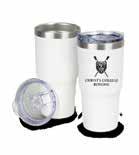
If your farmers are trying to work out which pasture cultivars represent best value for sowing this season, it’s time to point them to the latest National Forage Variety Trial results.
That’s the advice from Barenbrug pasture specialist Graham Kerr, who says the NFVT system, which has been running for more than 30 years, and the cultivars it tests, represent the best of what proprietary plant breeding contributes to New Zealand agriculture.
“We’re not just talking about superior plant genetics being extensively tested prior to market release.
“This is our way, and our industry’s way, of reducing the risk farmers take when they renew their pastures, so they
can be confident of a good outcome.”
And with high quality pasture more important than ever for efficient, profitable milk and meat production, carefully considering ryegrass choices before sowing is time well spent, he says.
Barenbrug ryegrass genetics continue to live up to their long legacy of high performance in the latest results, with Maxsyn NEA12 unbeaten among perennials for total yield in the national NVFT rankings. It’s not the only standout, however.

The company has bred three out of the top five perennials for total yield (Array NEA2 and Tyson NEA4); 4front remains the top tetraploid ryegrass tested, and Forge NEA is again unbeaten for total yield in the hybrid ryegrass trials, with Shogun NEA12 number two.
The results reinforce the company’s effort to develop ryegrasses that add value to today’s farm businesses, and are testament to the on-going efforts of its breeding and development team, Kerr says. They also highlight a strong family lineage in diploid
perennial ryegrass that goes back decades.
Maxsyn NEA12 is the latest release from these high performance genetics, built on predecessors which repeatedly set a high bar for performance, both on-farm and in the NFVT.
“From Yatsyn 1 at the start, to Bronsyn, through to Trojan, just to name a few, it’s a track record we’re really proud of,” Kerr says.
“Our new company strapline ‘Grow with confidence’ sums up what we live by - giving farmers great genetics they can be confident will deliver.”
The first calves of a new crossbred dairy-beef offering are now on the ground at a farm near Taupo, and the genetics will be commercially available from spring 2026.
Landcorp Farming and LIC say dairy farmers, calf rearers, beef finishers and processors all stand to benefit from the new breeding option.
The Synergizer brand brings together the very best of Stabilizer and Charolais genetics, developed in collaboration with Landcorp Farming subsidiary Focus Genetics.
The breeding programme focused on key traits including short gestation, ease of calving and rearing, strong growth and meat quality.
Synergizer bulls have been developed to produce polled calves that are easy to rear, with strong early growth, minimal calving difficulties and easy identification in the paddock via their coat colour.
They’re also selected for strong liveweight gain, and their ability to consistently reach target live and carcase weights.
LIC chief executive David Chin says the launch of Synergizer marks an important milestone in the co-op’s dairy-beef journey.
“Synergizer is an exciting step forward for LIC as we continue to invest in dairy-beef genetics that give farmers confidence.
“Backed by world-class science, robust data and rigorous progeny testing, Synergizer has been developed to deliver a reliable, profitable and sustainable option for dairy-beef systems.”
Landcorp chief executive Mark Leslie says Synergizer represents the power of collaboration and the potential
of New Zealand agriculture when organisations work together.
“By combining genetics expertise, farming knowledge, and a shared vision, we’re creating a solution that will deliver long-term benefits across the entire dairy-beef value chain and build resilience, productivity
and sustainability for future generations of farmers.”
The first frozen semen inseminations will be available in limited quantities from spring next year, with liquid insemination available from spring 2027.

Words: APHANZ
Farmers and R&D companies continue to provide feedback following the Agricultural and Horticultural Products Regulatory Review report released in February 2025.
Farmers need a broad toolkit, not a silver bullet to face a raft of challenges. They continue to wait for tools that farmers and growers overseas have been using for years.
R&D companies are continuing to scale back applications and trials, citing regulatory and operating environment hurdles. If a market cannot provide regulatory efficiency and certainty, farmers and growers miss out on innovative products.
Bayer, one of the world’s leading crop companies has
exited R&D in New Zealand. It says the regulatory landscape makes it “challenging to justify the company’s time and the expense required to commence research projects that introduce pipeline products”.
Syngenta, the world’s number one global biologicals producer, has made a recent commitment to remain in NZ but has avoided registering new actives for pests like grass grub and fall armyworm, warning “it is disappointing that farmers and growers are going to lose
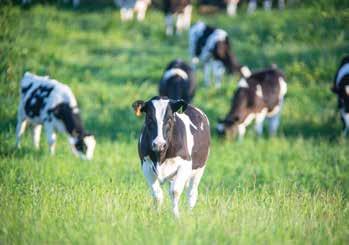
access to good world leading technology”.
Corteva Agriscience, which operates a world-class R&D facility in Taranaki, says “other countries have overtaken NZ”, and “farmers in these countries have faster access to the newest innovative chemistries and biological solutions”.
Sipcam, an Italian R&D company, says NZ has gone from being “among the most efficient regulators” to being seen as “competing to be the slowest”. The primary sector is the
engine room of our economy, and these tools are a third gear to lift sustainability and growth, improve environmental outcomes and replace older chemistry. If we want to attract innovation, we must create a regulatory environment that enables it. We can’t afford to fall further behind. Our farmers and growers need to replace older chemistry and deserve a level playing field—with access to innovation already available to their international counterparts.

Without predator control, these habitats and the native wildlife that depends on them will continue to decline — even with stock exclusion. Our toolbox will guide you through how to manage pests in these unique spaces.
Industry has recognised and is addressing an advisory system bias impacting on how crop protection knowledge is extended to growers, New Zealand’s largest farm supplier says.
The structure of NZ’s crop advisory system, with its strong links to commercial companies, helps shape what advice is delivered, and which types of knowledge are prioritised.
That’s according to research undertaken for A Lighter Touch by extension experts Scarlatti.
This was a recurring theme in data obtained from 51 survey respondents and two focus groups involving people working in crop protection extension in NZ.
PGG Wrightson technical team manager Milton Munro says the industry is aware of this bias towards product-based solutions and is working to address it.
PGW, for example, has worked with Primary ITO to develop an independent qualification for agronomists working in the horticulture sector, recognising they make critical decisions that determine crop success.
Internationally, agronomists must hold a recognised qualification but no such requirement exists in NZ.
“We’re training our people to take a more holistic approach to crop protection, because we recognise there needs to be a fundamental change in the industry,” Munro says.
“Resistance is a critical crop protection issue where we are going to see the rubber hit the road. The only way we are going to manage resistance is to embrace all of the tools available to growers.
“We need chemical control, biological control, cultural control. And we need to create a training pathway to support that approach, not just spraying our way out of the problem.”
Data from the survey of those working in extension, along with two focus group discussions, showed most advisors felt they have the time and basic resources to carry out their roles. However, many product groups have limited capacity to plan and deliver extension activities, revealing a systemic gap in the ability to extend new biological products to growers. In addition, significant capability gaps exist—particularly in behavioural change, facilitation, and systems thinking.
Many advisors reported learning extension skills on the job, with limited access to formal training or peer-learning opportunities.
In discussing the commercial bias
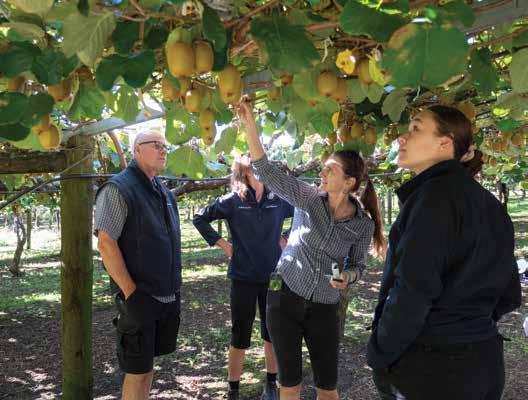
in the structure of advisory services, respondents acknowledged there are some independent crop protection advisors in the industry.
However, most are employed by companies that sell fertilisers, agrichemicals, or other inputs.
Although this model supports access to technical information, it also creates a bias toward product-based solutions.
“Ultimately, there is a misalignment between the commercial drivers of the current advisory model and the long-term goals of agroecological transition,” the Scarlatti report says.
“Even when scientific evidence supports a non-commercial solution, it may struggle to gain traction if it falls outside the remit of what an advisor is expected or resourced to deliver.
“As a result, the system may be reinforcing the status quo and slowing the uptake of more sustainable practices.
“Focus group participants described this as a major challenge, particularly for approaches that require systems thinking, long-term planning, or collective action— areas that commercial advisory models are
not typically set up to support,” the report found.
Succession planning was another concern, with many current advisors nearing retirement, and few structured entry pathways for those new to advisory and extension roles.
The demographics of respondents (82 per cent were at an advanced stage of their career) prompted focus group discussion on whether the sector was facing a generational gap.
There was broad agreement that fewer younger professionals are entering advisory roles.
Systemic challenges exist in attracting and retaining an extension workforce, with a fundamental issue being the lack of clear, structured training options for advisors and extension professionals in NZ.
Many advisors in the focus groups brought up examples from other countries where there are clearer training pathways, such as Ireland and the United States.
The absence of similar pathways in NZ possibly contributes to the gaps in capability identified, in terms of extensionspecific skills, the report found.


From July 2024 to June 2025, Land Search and Rescue volunteers undertook 526 search and rescue operations, saving 40 lives, rescuing 159 people, and assisting 219 individuals.
Their vital work was supported by 22,727 operational hours and an incredible 115,087 hours of training.

SUPPORT OUR VOLUNTEERS
SCAN TO DONATE OR LEARN MORE
WITH THANKS TO PGG WRIGHTSON FOR THEIR ONGOING SUPPORT OF LAND




Those behind the study say it’s a result that could help farmers increase returns and reduce reliance on traditional parasite controls.
The independent trial, published in the NZ Journal of Agricultural Research, is the first in New Zealand this century to quantify the impact of nitrogen fertiliser on animal production in
lowland sheep systems. While the pasture growth benefits of spring nitrogen are well known, few studies have measured how that translates into gains in livestock performance – until now.
Conducted by Bioeconomy Science Institute and supported by Ballance Agri-Nutrients, this study found a single application of nitrogen fertiliser post-
lambing resulted in a 33 per cent increase in pasture cover and an average five to six per cent increase in ewe and lamb liveweights at weaning.
The research was done at Woodlands Research Station east of Invercargill.
The fertiliser treatment comprised 40 k nitrogen/ha as liquid urea, applied by a commercial contactor on 25 September 2024.
Pastures used for the study are mainly perennial ryegrass and white clover, with some poa, browntop and crested dogstail.
The experimental area was set stocked with pregnant ewes as part of normal farm practice in early September; a total of 178 ewes and 311 lambs was used, and a wide range of animal and pasture measurements was taken from pre-treatment through to weaning.
“This study is a milestone that provides hard evidence for something farmers have anecdotally believed for years,” says Warwick Catto, science

strategy manager at Ballance.
“It confirms the gains are real and measurable – and importantly, it’s a practical, low-cost tool farmers can use during one of the most demanding periods in the sheep farming calendar.”
The research shows lambs from treated paddocks were on average 2.3 kg heavier at weaning, with nearly a quarter reaching slaughter weights, up from just seven per cent in the control group.
The increase in liveweight alone equated to an extra $90 per hectare in value, effectively covering the cost of the fertiliser while opening up options to sell more lambs earlier and reduce summer feed pressure.
Tactical use of nitrogen also improved ewe condition going into summer and created greater flexibility in pasture management.
These benefits come at a time when climate variability is increasing, and traditional tools like long-acting drenches are


A new precision horticulture tool that guides fruit thinning workers with more accuracy has the potential to reduce unnecessary fruit losses and save New Zealand orchardists thousands of dollars in labour costs.
Developed by Fruition Hawke’s Bay, the homegrown ‘Tagga’ solution combines Green Atlas orchard scanning with a GPS-guided line marking machine to map and precisely mark which sections of an orchard need thinning to improve fruit quality and yield.
“The feedback we were getting from orchardists was ‘your fruit density scans are great, but how do I make sure the 15 backpackers I’ve hired understand them and carry out my thinning instructions accurately?’,” says Alex Hoek, precision horticulture manager at Fruition Hawke’s Bay.
This birthed the idea of Tagga – a way of taking a grower’s instructions and physically laying them out in the orchard to remove the risk of less experienced workers thinning fruit in the wrong areas.
“The process involves digitally mapping an orchard using the Green Atlas Cartographer and then downloading that data to our Tagga line marking unit,” Hoek says.
“The Tagga unit is then towed around the orchard by an ATV, automatically spraying the ground as it passes over it to clearly and precisely mark areas where scan data shows thinning is needed.”
Trials conducted on kiwifruit last season showed significant labour savings and much more targeted crop removal.
Two comparable 1 ha blocks were used for the trial, with Tagga line markings used to guide fruit thinners on one block, and traditional thinning instructions based on a scanner-generated fruit density heatmap used as guidance on the other block.
On the block where Tagga was used, labour time for fruit thinning was 35 per cent less – a saving of 44 hours – when compared to the control block.
The Tagga block also experienced
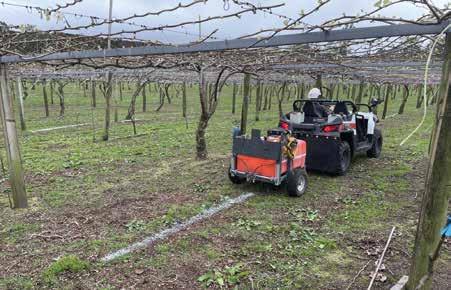
significantly less thinning of fruit in bays that were already below target, leading to around 60,000 fewer fruit being removed when compared to the control block.
“When we consider the value of gold kiwifruit, saving just 1,000 good pieces of fruit from being thinned pays for the Tagga application. Add to this labour savings and potential fruit quality gains, and it’s clear this can be a powerful tool for growers,”
Hoek says.
This year Tagga will be available as an on-call service for apple and kiwifruit growers in Hawke’s Bay and Bay of Plenty, but Fruition Hawke’s Bay is considering other service models that could allow orchardists to operate the units themselves in future.
“Precision horticulture is making waves internationally because of its potential to help orchardists tailor their approach to different parts of their orchard, whether for
nutrient treatment or deciding which specific vines or trees need spraying.
“The way we have used the technology for Tagga is the first time anywhere, to our knowledge, that precision horticulture technology has been used to physically spray the ground to guide horticulture workers.”
Hoek says Fruition Hawke’s Bay hope to build on the Green Atlas orchard scanning services it offers by developing even more precision horticulture tools to maximise grower efficiency and productivity.
“In the exact same way we are painting lines at the base of select trees, we could instead be spreading fertiliser, root pruning, or spraying plant growth regulators.
“As these technologies become more available to growers, the value that can be derived from Green Atlas scan data will only get greater.”
becoming less effective due to rising resistance.
“Worm resistance is a growing challenge on many farms,” says Catto.
“This study shows that lifting feed supply through spring nitrogen use can be another tool in the toolbox – not to
replace drenches entirely, but to reduce reliance on them.”
The work builds on Ballance’s announcement in November 2024 of new fertiliser-based trials targeting parasite burdens on pasture, a wider programme exploring how nutrition can support livestock resilience.
“We’re not talking about blanket nitrogen use,” Catto says. “However, when it’s used strategically, like in this trial after lambing, the benefits for pasture growth and animal performance are clear.”
The study is part of Ballance’s ongoing investment in
science-backed solutions for the primary sector through the Future Ready Farms programme, supported by the Ministry for Primary Industries’ Sustainable Food and Fibre Futures fund (now replaced by the Primary Sector Growth Fund).
Nearly 50 years ago, Stu Stokes was introduced to deer farming by his father Bruce, and it’s fair to say the passion stuck.
Today, he runs a red deer operation in the foothills just outside Springfield.
Across two blocks totalling just under 400 hectares, he manages more than 900 velveting stags, 700 breeding hinds, and around 600 replacement fawns.
Over the years, Stokes has dabbled in a bit of everything - cropping (grass, clover, peas, and barley seed), dairy support, and beef cattle.
But through all the changes, one thing has remained constant - deer.
While he initially focused on venison, the past decade has seen a shift in direction, with velvet production now taking centre stage.
A key part of his success comes down to a simple but effective philosophy: focus on the bottom 10 per cent.
“It’s about identifying what’s not working and doing something about it,” Stokes says.
In the velveting side of the business, applying the 10 per cent rule is straightforward. Velvet weights are recorded, and style is noted, making it easy to spot the underperformers.
In recent years, Stokes has moved to an electronic recording system, which has made tracking and decision-making
even more efficient.
When it comes to breeding, things get a bit trickier.
Stokes doesn’t single-sire mate or use genetic testing, so identifying the bottom 10 per cent of hinds requires a bit of creativity.
At weaning, he selects what he reckons are the bottom 10 per cent of fawnsthe ones he jokingly calls ‘pot lickers’ because they’re too small to even get a lick in the pot.
He then uses a mix of ‘milkies’ (a Vaselinelike substance) and food-grade dye to mark the tops of their heads.
After returning them to the hinds, he brings the mob back in a few days later. Any hind with a blue-stained udder or belly is matched to a marked fawn and removed from the breeding pool.
“If I paint nine fawns, I’ll usually find eight hinds with blue bellies - and I’ll know two of those fawns were twins,” he explains.
Stokes applies the same bottom 10 per cent philosophy to his pastures.
Each year, he identifies the lowestperforming paddocks, whether that’s due to weed pressure that can’t be easily controlled, slow regrowth, or poor grass, herb, or legume content.
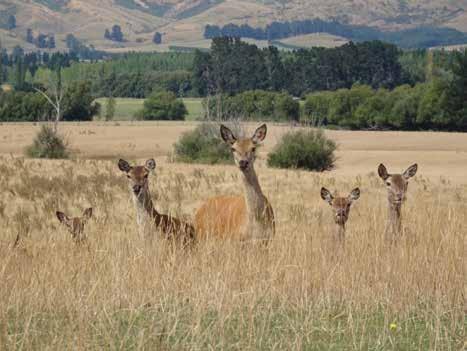
Once identified, these paddocks are pulled out of rotation and put through a winter cropping programme.
Stokes typically sows swedes and either kale or fodder beet, depending on the season and feed requirements.
This gives him a chance to reset the paddock and build fertility before resowing it into permanent pasture.
Of the forages he finds useful, SovGold kale, Jamon fodder beet, and Manta Italian ryegrass have all provided suitable quality and growth patterns that match the seasonal requirements of his deer property. Stokes’ approach to pasture renewal is another example of how he sticks to what works - applying the same bottom 10 per cent principle across different parts of the farm.
Recently, he was a guest on The Al & Juddy Show Podcast.
The podcast provides a bridge between the technical and practical side of implementing forages in farm systems, and is a great way to follow some of the ways Stokes makes these decisions and how his deer system has evolved over the years.
You can hear more on The Al & Juddy Show podcast episode ‘Shedding light on deer systems with Stu Stokes’.

Gallagher Animal Management has appointed senior insider Hamish Wiig as a nonexecutive director to the boards of Goodnature and Farmote Technologies.
Lisbeth Jacobs, who has been on the Goodnature board since 2022, will be stepping down from her post to take up a leadership role in Europe closer to family.
Wiig brings to the boards over 20 years of international leadership experience across telecommunications, food and beverage, and agriculture; and is a passionate advocate for sustainable practices.
Since joining Gallagher in 2021 as general manager for Latin America, Asia, the Middle East and Africa, he has successfully driven the company’s expansion into high-growth emerging markets across the globe, the company says.
“With his global perspective, multilingual expertise, and proven ability to scale businesses, Hamish is ideally placed to contribute to the growth and governance of both Goodnature and Farmote.”
Wiig says he’s thrilled with the appointment.
“Both companies bring something unique
to Gallagher’s vision for smarter, more sustainable farming — Goodnature as a global leader in humane pest control, and Farmote with its breakthrough pasture monitoring technology.
“I’m looking forward to working with their teams to help unlock opportunities and take both businesses to the next level.”
Dave Shoemack, Goodnature CEO, says Lisbeth Jacobs has been an incredible asset to its board in recent years.
“At the same time, we’re delighted to have Hamish picking up where Lisbeth left off, and confident that his passion for sustainability and experience scaling companies globally will be a valuable addition to our advisory team.
“I’m particularly excited about the hard-won insights Hamish will be able to bring regarding markets where we have significant growth opportunities throughout Latin America, the Middle East, Africa and Asia.”

Wiig’s appointment reinforces Gallagher’s commitment to maintaining strong connections with Goodnature as the company continues its global growth. Goodnature is already recognised as a world leader in non-toxic, humane pest control and is well-positioned for further international expansion.
Farmote Technologies, a joint venture between Gallagher and Barenbrug launched last year, is redefining pasture monitoring with cutting-edge sensor and satellite technology.
Its integration into Gallagher’s ecosystem, alongside innovations such as eShepherd, remote in-paddock weighing, and liquid monitoring, will enable farmers to embrace holistic, data-driven precision farming.
PGG Wrightson has renewed its partnership with Land Search and Rescue New Zealand, sponsoring it for another three years.
Since first partnering in March 2021, it says it has seen firsthand the impact Land Search and Rescue has on communities across the country.
With many of its team members and clients regularly enjoying NZ’s great outdoors, supporting the organisation’s life-saving work is close to home.
In the 2023/24 financial year, Land Search and Rescue volunteers completed 526 search and rescue operations, assisted 418 people, and saved 40 lives.
These efforts were made possible by the dedication of volunteers who contributed over 150,000 hours of service.
Operations included support for cognitively divergent individuals in urban areas, reflecting the breadth of Land Search and Rescue’s reach across both
remote and populated regions.
PGW says it is proud to be part of the organisation’s Valued Employer Programme, which recognises the important role employers play in enabling volunteers to respond to emergencies.
Among those volunteers is Aaron Thompson, a technical horticultural representative based in Marlborough, who has been involved with Land Search and Rescue for nearly a decade.
“I’m really pleased that PGW is supporting Land Search and Rescue on a national level,” he says.
“There are many synergies between the two organisations, especially the rural aspect. PGW has always been supportive towards my involvement with Land Search and Rescue.”

A new cross-sector body aims to deliver better long-term outcomes for the New Zealand strong wool industry, generating greater demand, lifting value and avoiding costly duplication.
The Wool Alliance, a formal agreement between Campaign for Wool NZ, Wool Impact, the Wool Research Organisation of NZ and Beef and Lamb NZ, is a first-of-its-kind industry model to enable wool’s economic stability and growth, and safeguard lasting capability for the sector.
Former Fonterra chair, John Monaghan, has been appointed the independent chair of the Wool Alliance, and charged with leading the roll-out.
He’s realistic about what is
required to lead the wool sector at such a critical time.
“I see real opportunity for strong wool to lift its value and visibility globally. But it’s not a straightforward pathway,” he says.
“Currently, we have multiple bodies competing for funding. Consolidation is the obvious solution, and it’s what growers want. The Wool Alliance needs to show up differently, cooperate and collaborate to create a lean and sustainable structure.”

The establishment phase will focus on market enablement, pre-competitive support, and delivering a strong, united voice for NZ wool.
“Wool is a cornerstone of our NZ identity, and it’s important it remains so.”
Implementation of an enduring model for New Zealand strong wool is expected in 2026, following extensive consultation with industry partners, testing and refinement.
The Wool Alliance says beneficiaries of this work will
be broader than wool growers, with advantages felt far beyond the farm gate.
Early-stage funding will come from existing resources, although other funding sources will need to be considered as the model evolves.
“There’s a big job ahead of us to build the industry up again and establish an enduring model for wool that really works. It’s a great challenge and one I’m pleased to bring my experience and enthusiasm to,” Monaghan says.
The Kapuni gas to urea plant in Taranaki, operated by Ballance Agri-Nutrients, will continue operating until 31 December after short-term gas supply was secured in September.
“The co-operative continues to actively seek both short and long-term affordable gas supply agreements.
“A short-term shutdown of the plant remains a possibility if further reliable and affordable supplies cannot be secured beyond 31 December 2025,” the company says.
The plant has operated since 1982 and employs more than 120 people.
Approximately one third or 260,000 tonnes of New Zealand’s urea is manufactured at the plant annually, specifically for use as a nitrogen-rich fertiliser.
In August, Ballance CEO Kelvin Wickham said Kapuni could shut for up to four months because gas was too expensive.
“We recognise the significant impact even a short-term shutdown would have on our employees, shareholders, the wider agricultural sector and the Taranaki regional economy,” he says.
“Like many businesses, we’re impacted by dwindling NZ gas supplies.
“We’ve been working hard to secure a reliable gas supply agreement at a price that is affordable for the business and our shareholders as NZ farmers and growers,” he said.
With spring here, the focus has been on ensuring enough nitrogen fertiliser is
available for farmers and growers in the weeks ahead.
“We’ve secured contingency supplies of nitrogen for spring and our industrial customers have sourced alternative supplies for their GoClear customers, keeping NZ’s trucking fleet on the road.”
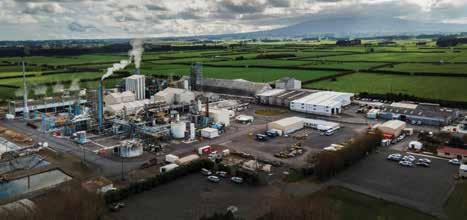
Bay of Plenty technical lab manager Phoebe Scherer has won the coveted 2025 Young Grower national title.
Scherer works for Apata in Tauranga and is also the Bay of Plenty regional champion.
The 29-year-old recently competed against six other regional winners in a series of challenges at Lincoln University in Christchurch.
Runner up was Steven Rink, the Canterbury regional champion, who is a production manager for Oakley’s Premium Fresh Vegetables in Southbridge.
Third spot went to Amelia Marsden, representing Nelson, who is a kiwifruit manager at Willisbrook Orchards in Brightwater.
The seven finalists competed in a series of practical and theoretical horticulture modules, testing their vegetable and fruitgrowing knowledge and skills needed to be successful growers.
Scherer says she thoroughly enjoyed stepping up to the many challenges.
“The science and technical modules were my ‘safe space’ but others I found much more challenging, particularly the machinery section.
“We had to drive a big tractor along a GPS line. It was the biggest piece of equipment I have ever stepped into but we were very well supported.
“It was a very high calibre field of competitors and everyone did so well. I could not have asked for a better cohort to have shared such a great experience with.
“In some ways, it didn’t feel as if we
were competing because we were all so supportive of one another – it was more like being among friends, all going out there to take on the challenges and do our very best.”
Scherer gained an evolutionary biology degree and did an OE before taking a job in the kiwifruit industry in Tauranga seven years ago.
That led to a laboratory job and ongoing career progression.
She joined Apata, a specialist service provider for New Zealand kiwifruit and avocado growers, last year.
The Young Grower competition celebrates the success of young people in the industry as well as encouraging others to consider a career in horticulture.
Scherer also won the Best Technical award and Steven Rink the Best Innovation award. Lydia Goodman, representing Central Otago, won the Outstanding Leadership Award. Goodman is assistant orchard manager at Central Orchard Management and Packing Manager at CentralPac.
Regional organisers host and run the regional competitions independently, with Horticulture New Zealand hosting the final in a different part of the country each year. Entry is open to both commercial fruit and vegetable growers from across the regions, up to the age of 30,
HortNZ chair Bernadine Guilleux says the regional and national competitions play an important role in raising awareness about
the many career and personal development opportunities across the horticulture sector.
“The exceptional skills we once again saw in all our finalists, and the support, passion and enthusiasm from participants, organisers and supporters really sums up the spirit of the horticulture sector.”
HortNZ chief executive Kate Scott says it’s an exciting time for the industry as it focuses on an ambitious goal to double the farmgate value of horticulture in NZ.
“We need many more highly skilled young people, like our finalists, who want to build rewarding careers in jobs they really enjoy, take advantage of the many opportunities for professional development and be prepared to step up as the leaders of the future.
“There are many opportunities, from crop management and machinery operation to soil science, quality control and marketing and much more. We are always very happy to hear from young people who would like to know more about the range of options the industry offers.”
Fellow 2025 finalists were:
Gisborne: Rhiannon Morrell, a member of the technical team for apples for Craigmore Sustainables.
Hawke’s Bay: Sam Carter, from Havelock North, assistant manager for T&G’s Pakowhai Sector.
Pukekohe: Crop manager Jack Haddon who oversees the cauliflower and cabbage operation for Balle Brothers.

Ravensdown South Island shareholders have voted Jane Smith to the co-op’s board for a three-year term.
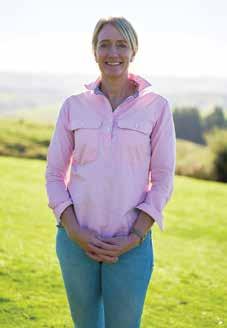
Chair Bruce Wills says this year’s election generated a lot of interest among shareholders, with over 25 per cent of the co-operative’s South Island transacting shareholders voting, representing nearly 39 per cent of the shares held by that group.
“With her passion for Ravensdown and knowledge of the wider primary sector, voting shareholders have recognised Jane’s alignment to the co-operative ethos - a core governance attribute.”
Smith runs Newhaven Farms, a 9500 stock unit sheep and beef farm, which includes stud sheep and stud beef operations supplying genetics around New Zealand and abroad.
Her governance experience includes six years as an independent director on the Red Meat Profit Partnership, a $64 million programme between agribusiness and government partners focused on driving
long-term profits for NZ’s red meat sector. She also served a term as a Crownappointed layperson on the Veterinary Council of NZ, the statutory board responsible for regulating the profession.
Bruce Wills has also thanked outgoing South Island director, Nicky Hyslop, for her service and commitment to the Board.
“Her commitment to the co-operative and contribution to the governance of Ravensdown has been highly valued by me and the wider board.
“Thank you too, to Rebecca Keoghan for her participation in this year’s South Island director area election round.”
Jacqueline Rowarth was the only candidate nominated for the North Island director area.
As a result, there was no election for the North Island and Rowarth remains a director for a further three years.

As part of Greenlea Premier Meats’ continued focus on growth and leadership development, long-time team member Aaron Craig has been appointed general manager of Greenlea Premier Meats.
His story with Greenlea spans more than three decades; a journey that began in the early 1990s after a couple of years on the farm.
He joined the meat industry soon after and proudly boned out the very first beast processed at Greenlea in June 1993.
Having learned every role within the plant, Craig left Greenlea to expand his knowledge as a butcher, working in home kill and smallgoods manufacturing before returning to Greenlea in 1999.
He went on to complete a Diploma in Meat Technology and Management, setting the foundation for his rise through the company to become plant manager, then operations manager, and now general manager.
Reflecting on his journey, Craig says: “Over the 30 years I have worked with Greenlea I have learned many things, the most valuable being ‘you learn something from everyone’ and ‘you never stop learning’.
“I also believe the transition from good to great doesn’t come from reading and understanding a book.
“More so, I believe going from good to great
comes from reading and understanding people. People are Greenlea’s greatest asset, and I am both proud and privileged to have worked alongside so many great people over so many years.”
In his new role, Craig’s leadership now extends beyond operations to include procurement and marketing, ensuring Greenlea continues to thrive with the same strong values and people-first approach that have long defined the business.
Greenlea’s managing director, Tony Egan, says he’s delighted Craig has moved into the new role as part of ongoing planning for the company’s future.
“These changes represent a natural progression within the business, supporting both continuity and growth as we look ahead.”
Egan continues as managing director, overseeing the businesses that make up Greenlea Group.
In his new role, Craig will expand his responsibilities across operations, procurement and marketing, ensuring that Greenlea Premier Meats continues to

operate strongly and sustainably.
These changes are about more than titles, Egan says.
“They reflect our commitment to providing growth opportunities for our people; ensuring Greenlea remains well-led into the future and building on the strong foundation already in place
“With thoughtful planning and gradual transitions, I’m confident this step will further strengthen Greenlea and position us well for the years ahead.”
Craig’s appointment is both a recognition of his extensive contribution and a reflection of Greenlea’s enduring philosophy: that people are at the heart of every success.
His leadership continues to build on the company’s proud legacy, driving Greenlea Premier Meats forward with integrity, innovation, and care for its people.
David Parker has retired from Bayer CropScience after twenty years and says while he’s looking forward more family and leisure time, New Zealand’s primary sector has given him a fantastic career.
He joined the industry with then Wrightson NMA in Horowhenua in 1984, responsible for new business development covering horticulture and emerging kiwifruit exports for the company.
Moving back to Canterbury to join Fruitgrowers Federation, he saw the rise and fall of the pipfruit industry, and subsequent business diversification throughout the region.
Employment with Ravensdown then catapulted him into technology and a big picture perspective of the greater agricultural sector.
He looks back on many highlights during his time with Bayer, starting with the launch of Proline in 2005, and regards Bayer as the tall pole in the tent, bringing innovation to the industry and improving farm profitability.
“It’s been a privilege to work for a company
such as Bayer that is responsive to industry needs by providing modern novel solutions to the farming community.
“I’ve been fortunate to have been employed by companies with an employee focussed culture, and to enjoy many long term relationships in the industry.”
Time with family and grandchildren is now a high priority, as is pursing other interests such as fishing and travel.
After 20 years in industry good research, one of the arable sector’s best known plant scientists is back in the field full time, and he’s loving it.
Richard Chynoweth joined MRB in Ashburton as an independent agronomist/seed production specialist in July having spent most of his career up until then with the Foundation for Arable Research.
The change means much less office and computer time, and much more time on farms across Canterbury helping individual growers maximise seed and grain production, while optimising their cost of production.
There are still data to analyse and reports to write, but monitoring crops every week puts him back closer to his
practical, outdoorsy rural roots, and the time was right for a change, he says.
“It was now or never!”
Chynoweth joined FAR after three years working in high grade seed production at thenWrightson Kimihia, and seed was at the heart of his extension and research at the Foundation from start to finish.
His time there included undertaking both a Master’s and a PhD in perennial ryegrass seed production, and over two decades he tackled performance, production and agronomy challenges for virtually every major seed crop in the New

Zealand arable sector, from white and red clover to beet to cocksfoot.
Raised on a farm near Ashburton that was predominantly in crop by the time he was in high school, Chynoweth says his interest in forging a career in the arable industry was sparked by agronomists visiting the property to advise on crop inputs and management. It only took six or eight months at Lincoln University as an agricultural science student to work out plant science was more interesting than animals, and he’s been studying plants in one
One of Corteva Agriscience’s most recent appointments may be new to the company, but he’s far from new to the South Island primary sector.
Based in Cromwell, Huw Murray has taken over the territory sales manager role for Otago and Southland from Morgan Mansell, and is now responsible for supporting Corteva customers from the Waitaki River south.
He comes to the company after close to five years looking after the region’s farmers as pastoral agronomist for Carrfields, and brings a wealth of experience in field roles across seed, fertiliser and agronomy with Barenbrug, Ravensdown and Farmlands respectively.
Corteva country leader Glen Surgenor says it’s this breadth of knowledge that saw Murray secure the role, along with his strong connections to the land and end users.
“We’re excited to have Huw join the team.” For his part, Murray says he’s always
wanted to add crop protection to his skill base, and Corteva’s strong reputation for both company culture and products made it the perfect opportunity.
Raised on a high country farm at Tekapo, agriculture was always his first career choice, and his various roles since joining the industry have added a solid grounding in dairy and arable to his foundational experience in red meat.
Now the Corteva role brings horticulture to the mix and he’s looking forward to the challenge of learning the ins and outs of another key sector.
Outside of work, he keeps busy with a young family of three daughters; loves to ski in winter, makes the most of southern water sports in summer, and hunts when he gets a chance.
His predecessor Morgan Mansell has been
sense or another ever since. At the time he joined FAR, “we were more project managers than researchers, but that evolved a lot over the years as the wider research sector in NZ changed, and our work became increasingly driven by growers themselves telling us what they needed”.
Chynoweth joins six other independent farm advisers with a wide range of farm management expertise at MRB: Jeremy Savage, Anton Nicholls, Mark Everest, Jamie Gordon, Trevor Gee and Sarah Hawkins. He can be reached at 021 860 246.

promoted internally to the role of Corteva technical specialist, replacing Nicole Morris who in turn was promoted to marketing manager earlier in the year.
Murray can be reached at 027 445 1799.

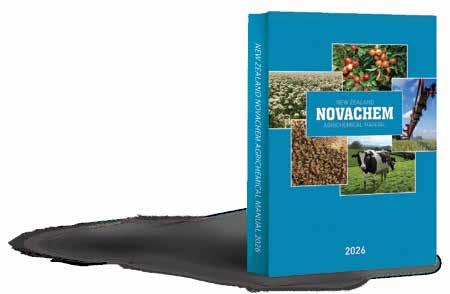
• Over 110 new listings
• 70 discontinued products
• Numerous product label updates (new weed, pest & disease claims)
• All product labels reviewed for regulatory content and updated to GSH terminology.
The definitive guide to agrichemicals registered for use in New Zealand.
A comprehensive alphabetical listing of products, active ingredients, crop & weed tables, weed & pest identification and much, much more all in one single publication. It really is the definitive agrichemical guide and the only one you’ll ever need.
Purchase a manual to receive a FREE 12-month subscription to our subscriber only website.
The website is continually updated and contains product listings, a fully searchable online product manual, a powerful search engine of weeds, diseases & pests, including photo galleries with all the agrichemical options to use on individual crops as well as up-to-date SDS’s, Haznotes and product labels, plus posts about industry news and information.
Order Now to receive your FREE pair of SureShield Coveralls

SureShield Coveralls supplied by pH7, provides both protection and comfort with exceptional liquid and particulate protection.
Category III, Type 5, Type 6 certified coveralls.
Ideal for asbestos removal, spray painting, low hazard pesticide spraying, boat building, dusty areas and general light industry.
These are best suited to spraying diluted chemicals such as round up for the fence lines, general maintenances on farm, or when spraying from a airconditioned cab.
One size fits all. Supplied by pH7.
* Available to those who order directly from www.novachem.co.nz - while stocks last.
Storing Chemicals?
Print up-to-date SDS’s & Haznotes from novachem.co.nz to ensure you are compliant.
New Zealand’s citrus industry recently gathered to celebrate excellence, innovation, and leadership at the inaugural Citrus NZ Industry Awards.
Held in Gisborne, the awards evening brought together growers, packers, researchers, and industry partners from across the country—a rare opportunity for the citrus community to step back from orchard rows and packing lines to acknowledge its people.
John MacPherson was honoured with the Industry Champion Award and Life Membership, recognising more than four decades of outstanding contribution to the sector.
MacPherson was celebrated for his leadership, mentorship, innovation, and unwavering dedication to horticulture and advocacy.
The Excellence in Orchard Sustainability and Practice Award went to Maziki Farms, a Gisborne-based operation run by Phil Evans, whose orchard exemplifies environmental stewardship.
Evans’ work includes innovative, sustainable orchard practices, restoration of waterways and biodiversity, and an active role in championing community-led catchment care.
Emerging talent was also recognised, with James Torrie from Wi Pere Trust receiving the Emerging Leader Award.
Torrie has led innovative nursery and orchard operations, championed sustainable practices, mentored others, and inspired the next generation through his commitment to excellence, collaboration, and community engagement.
The Innovation Award was presented to
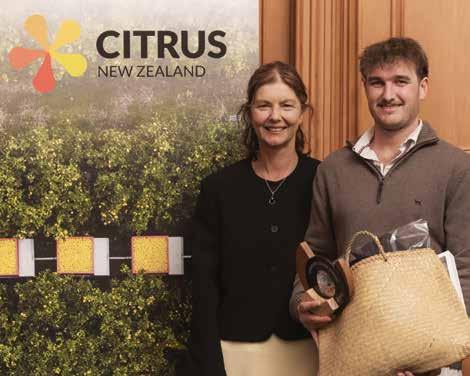
Henry Witters, co-founder of ’73 Citrus.
Witters and partner James Crowe transformed a family orchard into a nationally recognised sparkling orange juice brand, demonstrating remarkable creativity and a commitment to setting new benchmarks in New Zealand citrus.
“These awards are about shining a light on
the people who make our industry what it is,” says Citrus NZ interim chair Tam Jex-Blake.
“We’re a small but incredibly passionate sector, and it’s important to recognise those who go above and beyond, from the innovators to the steady hands who’ve built the foundations we rely on.”
Forage and crop genetic supplier RAGT New Zealand has appointed James White as its new commercial director.
White’s strategic elevation to commercial director signals its increased commitment to delivering profitable, sustainable solutions for NZ farmers, the company says.
With 19 years’ experience in the business, his clear future vision prioritises research and development to address
complex agronomic challenges.
This amplified focus is crucial as the sector navigates increasing pressure from environmental regulation and the persistent need for feed security and higher on-farm productivity.
RAGT NZ’s focus on innovative genetics and seed technologies—such as
market leading perennial grasses and revolutionary novel endophyte—is set to be a key pillar of White’s leadership.
White’s appointment follows the successful tenure of Bruce Garrett, who successfully led the business through its significant transition from Seed Force to a fully-fledged RAGT subsidiary.

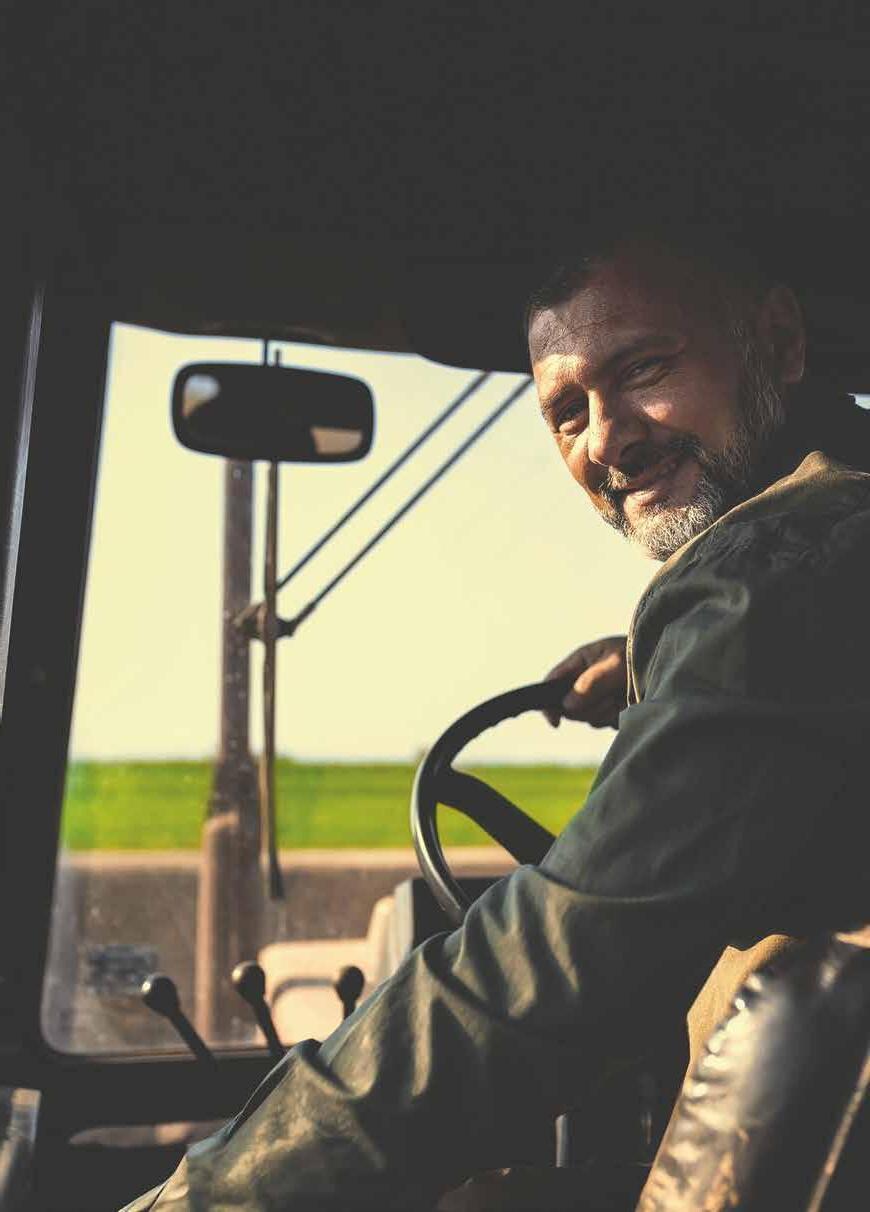
To love and succeed at farming, you have to enjoy solving problems. The next potential setback is never far away. The entire farming community must work together to hit new heights in order to overcome the biggest challenge of all: feeding a growing population with reduced access to farmland.
Fortunately, we now have better solutions than ever before to help you to continue to make great decisions, while doing what you love.
The challenge is big, but so too is the appetite for success.
